Some truly incredible donations to share regarding our work on Boeing B-17F Lucky Thirteen.
First, the armor plate for the cockpit door has finally arrived. This piece comes to us from Sam Coleman and Paul Teal, the admins of the RAF Grafton Underwood WW2 Memories Facebook page. Not only is this piece rare (we know of no other surviving example), but it is also a veteran of the 384BG – the same unit in which Lucky Thirteen served! Sam inherited this piece from her father Quentin Bland, who is a legend in the 384BG family for his efforts to preserve the memories of the old airbase.
The Boeing B-17 was one of the most heavily armored aircraft of the Second World War and it remains impressive even by modern standards. The armor plates were made of rolled homogeneous steel under specification AN0S-1, the modern equivalent of which is MIL-DTL-12560. The vast majority were .25 inches thick, though the plates in the stinger-type tail (on which the gunner braced his chest) were slightly thicker at .32 inches. F-models, like Lucky Thirteen, were the most heavily armored B-17 variant, with most plates being mounted at Stations 3 (back wall of the nose) and 4 (the back wall of the cockpit) to protect against head-on attacks. This newly donated piece mounts to the wooden door which separates the bomb bay from the cockpit.
Words can hardly describe how special this piece is to us. Please support Sam and Paul’s RAF Grafton Underwood WW2 Memories and do the same for the 384BG Grafton Underwood Museum project, which seeks to erect a museum by restoring the airbase’s sole remaining structures.
Next up is something not as evident to the casual observer.
Regular followers might remember that our friend Richard Boyens donated a NOS BC-375 Transmitter to the project back in February. This unit was the centerpiece of the B-17’s SCR-287 Liaison Radio system, coming to Richard directly from the UK, where it had been sent as a replacement unit and never issued. These units are often found without their four VT-4 vacuum tubes as these gigantic pieces are highly prized in the vintage electronics community. How prized? Well, they average 1,000 USD a piece…
So, you can imagine my shock when Curtis Nixon of Livonia, Michigan offered to donate a complete wartime set to the project! (These tubes were also tested to confirm that they are still operational…) Curtis is the owner of VizKey, a fabricator of custom Morse keys that are truly beautiful works of art. Our heartfelt thanks to Curtis for this incredible contribution, and for our radio enthusiast followers, we highly suggest you checkout his website.
Next, is another piece of our effort to gather the various manuals applicable to the Boeing B-17 – the B-17F’s Operations Familiarization Manual.
Throughout the B-17F series, the aircraft came standard with a pair of familiarization manuals: an operations manual and a maintenance manual. While the maintenance manual is by far the larger book, it is the operations manual which are highly sought after by collectors today. As such, they are generally far more difficult to find. This beautiful example was donated to us by Bill Spirk of Deming, New Mexico, who fought in Vietnam as an artilleryman with the 25th Infantry Division. Thanks Bill!
Last is a piece which came to us from the team restoring the B-17G Preston’s Pride in Tulare, California – it is a rain cover for the tail gunner’s cupola. This particular example appears to have never been issued and, due to the shade of olive drab, appears to be a late-war issue. More than likely, it was packed away due to the prevalence of Cheyenne-type tail guns toward the end of the war. The shroud fits perfectly though the clips which hold it in place have been removed on our stinger by one of its previous owners. Thanks guys!
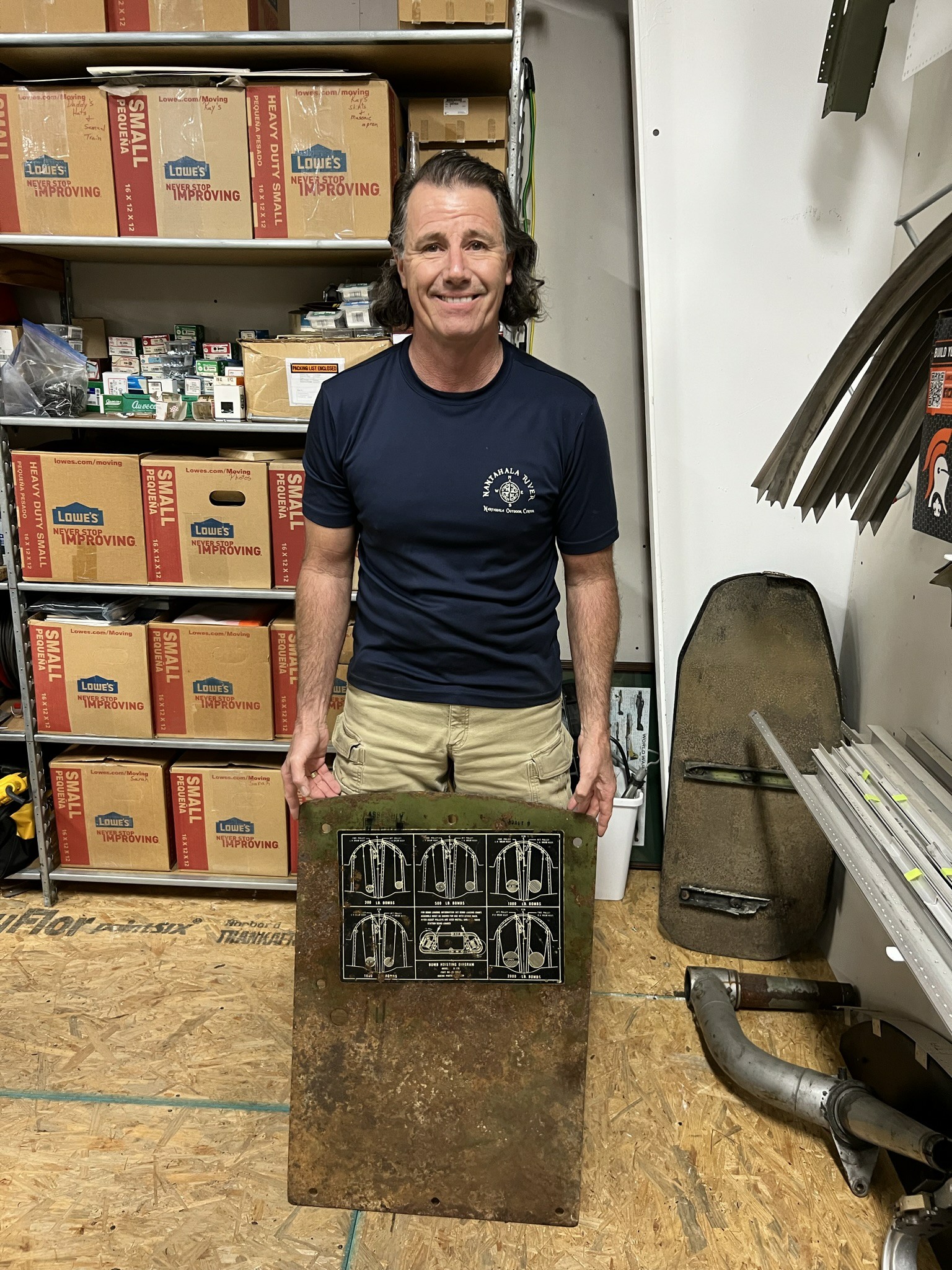
Ray poses with the newly-donated cockpit door armor plate. The decal is a loading chart for a Boeing B-17G. This chart has been carefully scanned, cleaned, and recreated so that it can be also be used by future projects.
Behind Ray are a pair of armor plates for the aircraft’s pilot seats. These were donated by Brian Freer of Farlam, England in 2019.
Photo taken 23 May 2023.
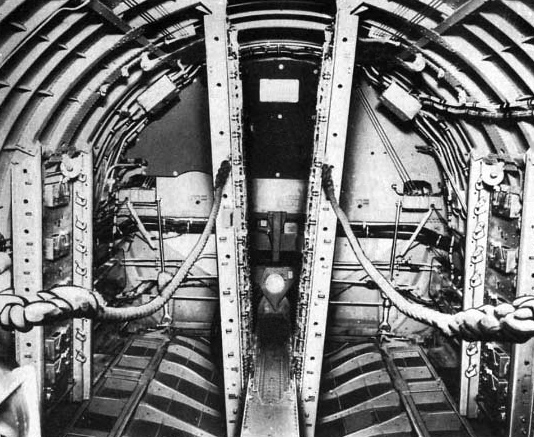
Looking toward Station 4 from the back side of the bomb bay compartment. The cockpit door armor plate is center.
We can tell that this is an older B-17 (an E or F-model) due to the loading chart being made of white cardstock rather than a waterslide decal.

Chart showing the armor complement aboard a typical F-model B-17.
The setup aboard Lucky Thirteen was identical to this, though her radio operator’s seat was a Cramer posture chair rather than a bucket seat with an armor plate.
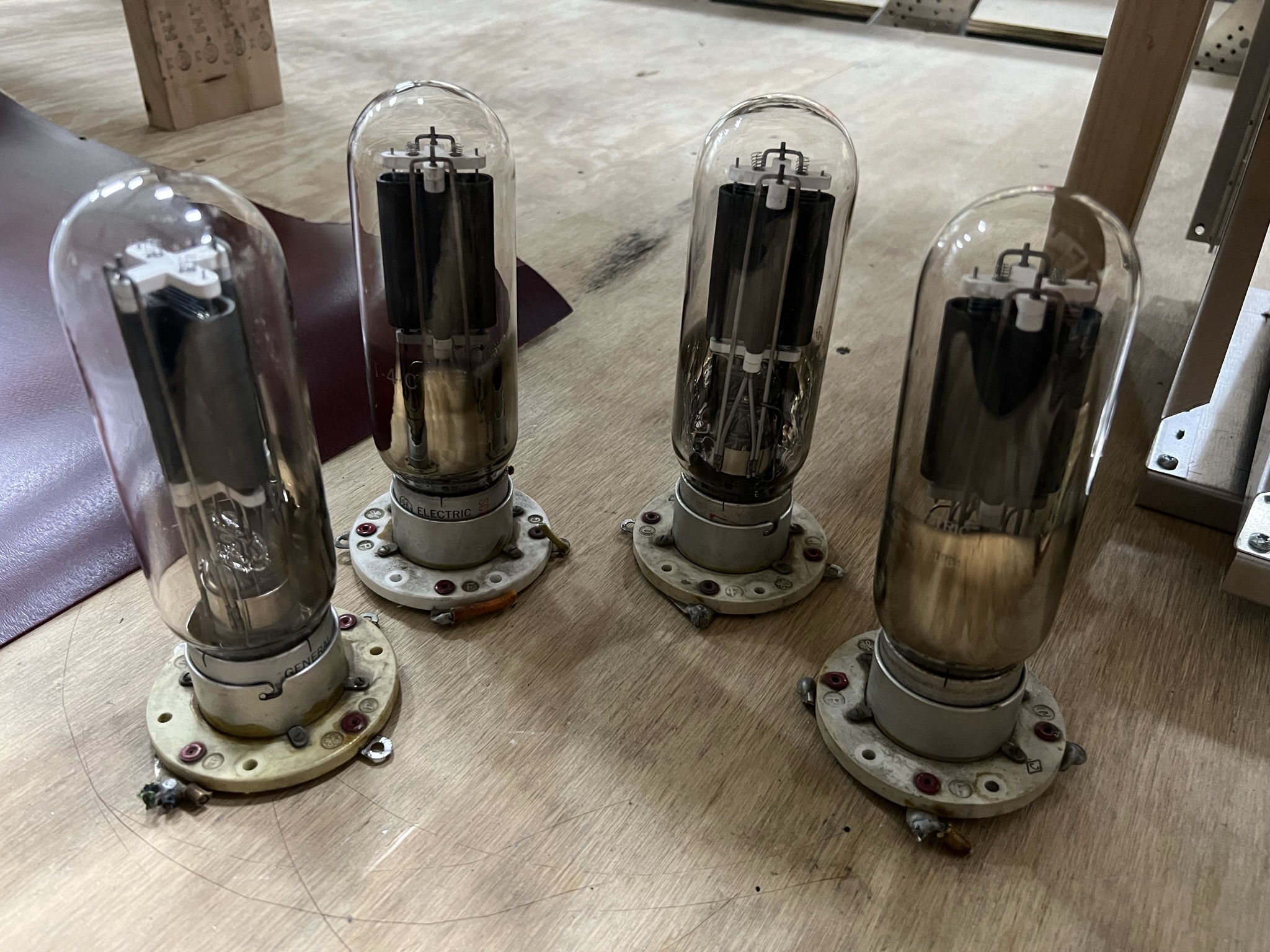
The newly donated VT-4 vacuum tubes from Curtis Nixon.
Photo taken 26 April 2023.

The BC-375 Liaison Transmitter donated by our friend Richard Boyens.
The two handles on the bottom are for the transmitter’s tuning unit. Depending on the variant, the B-17 could carry as many as seven tuning units, each covering a different frequency range. To change the frequency range, the radio operator simply pulled the unit out and slid another one in.
Photo taken 23 May 2023.
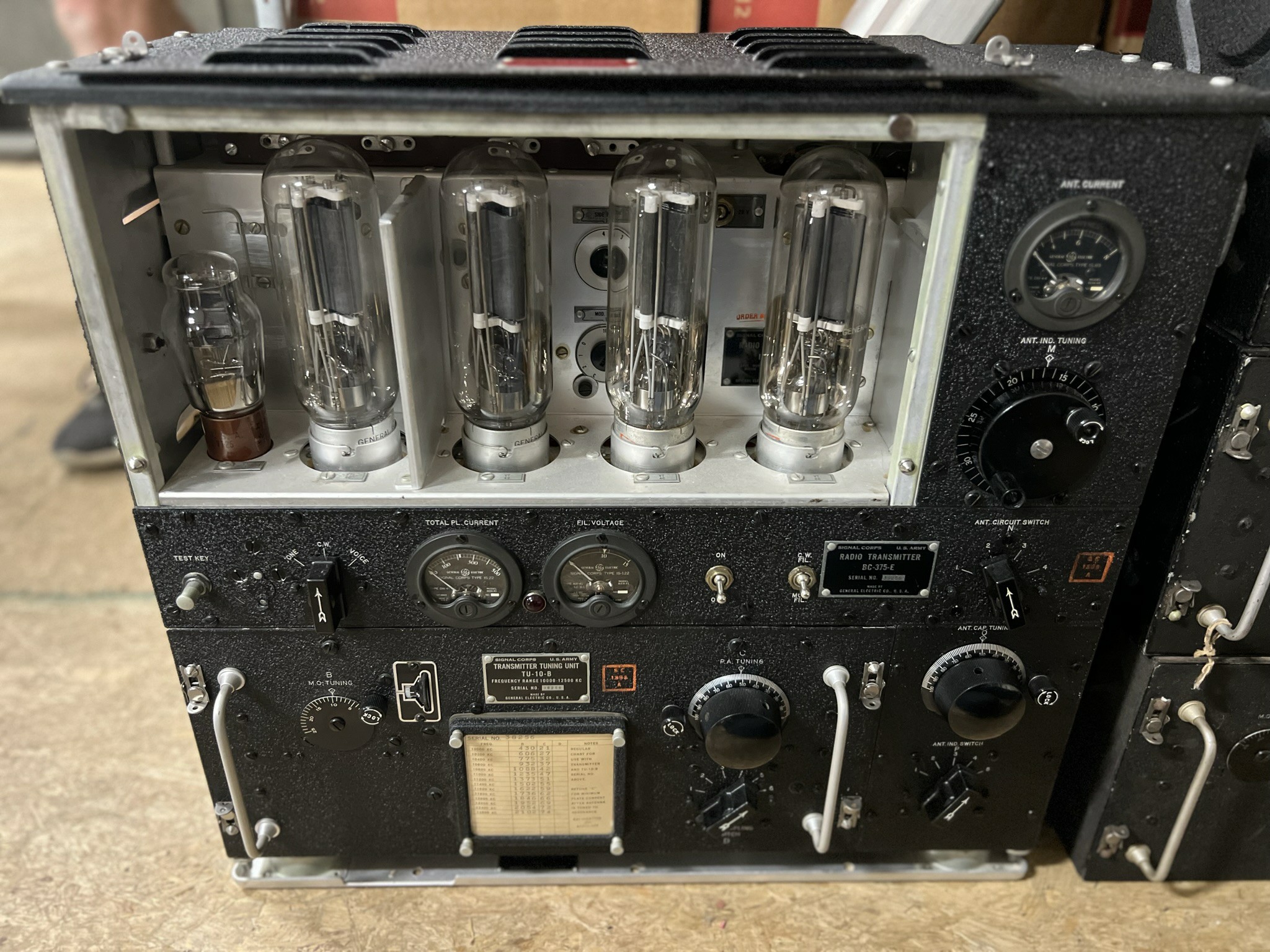
The newly donated VT-4 vacuum tubes are installed. It is incredible to think that, all together, these tubes are worth nearly 5,000 USD!
Even crazier is the realization how this project reaches the far corners of the earth. The radio came from England, the VT-4 tubes from New Mexico, and the small VT-25 tube from a collector in Japan.
And all are wartime original.
Photo taken 23 May 2023.

The transmitter assembly for the SCR-287 Liaison Radio aboard a Boeing B-17E. The radio setup you see here was standard on most B-17s.
Five of the tuning units are visible on the left. Between them, they cover frequencies ranging from 1500 to 12500 KC.
Various functions of this system include listening for strike recalls, relaying position in event of an emergency, and communicating weather patterns. Later in the war, special tuning units were introduced that, when tuned to German frequencies, served as a jammer by broadcasting white noise.
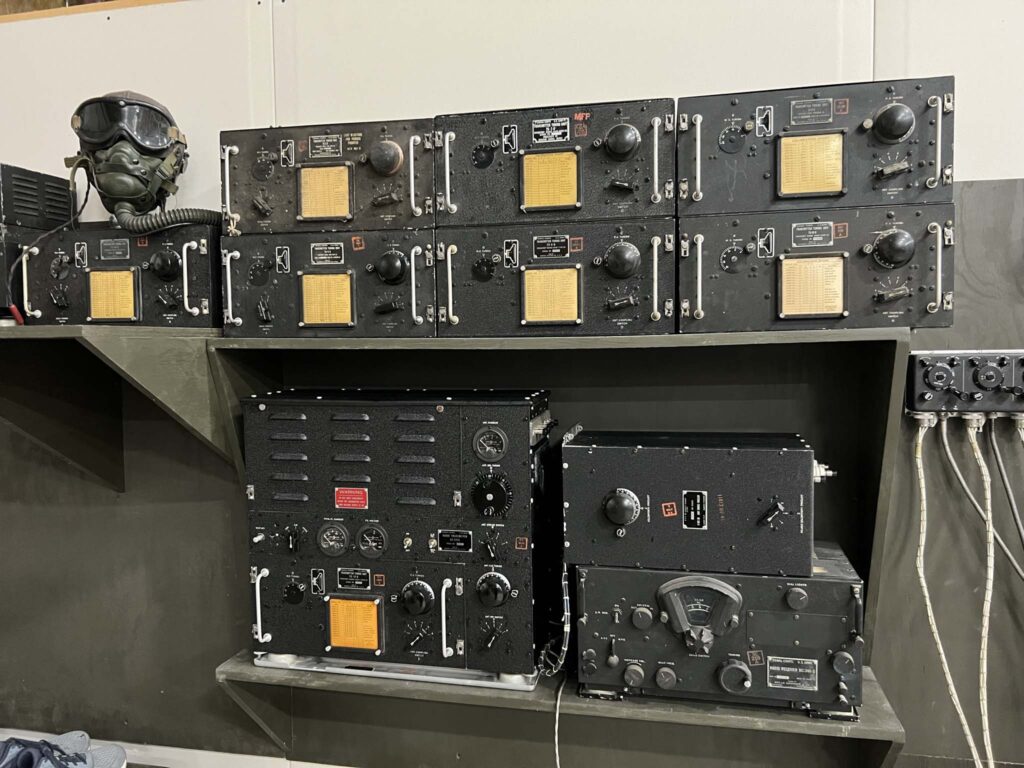
The complete SCR-287 Liaison Radio system for Lucky Thirteen.
Photo taken 8 February 2023.

The newly donated B-17F Operation Familiarization Manual from Bill Spirk.
Photo taken 29 April 2023.
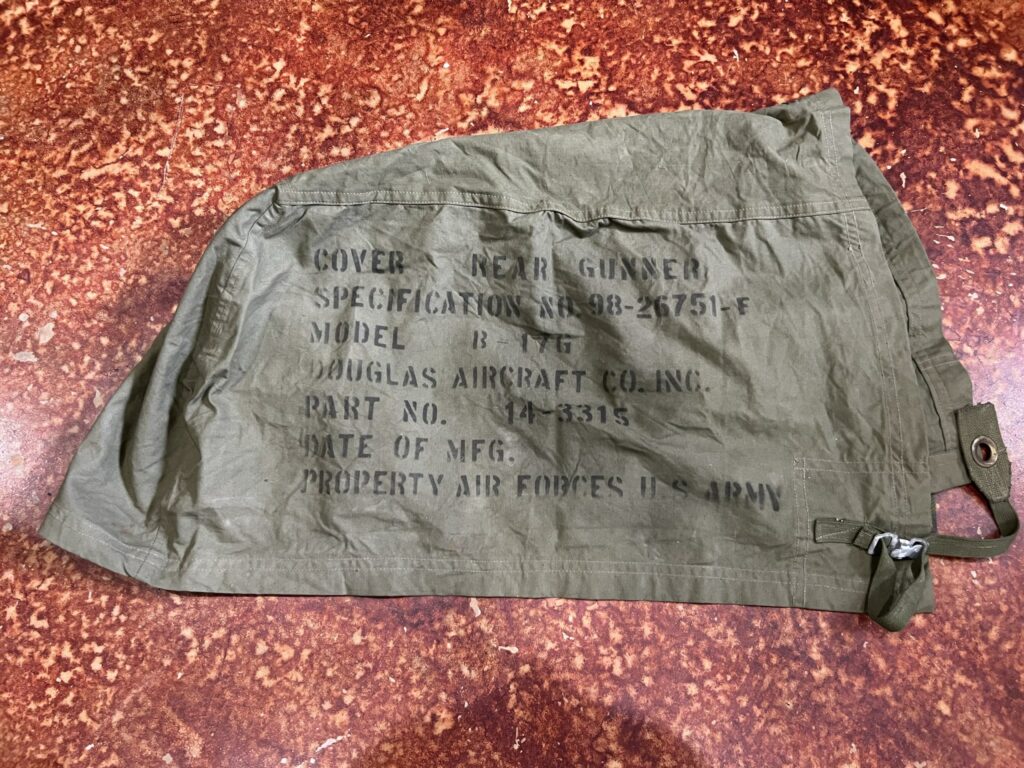
The newly donated tail gunner rain cover from the team with Preston’s Pride.
Photo taken 28 April 2023.
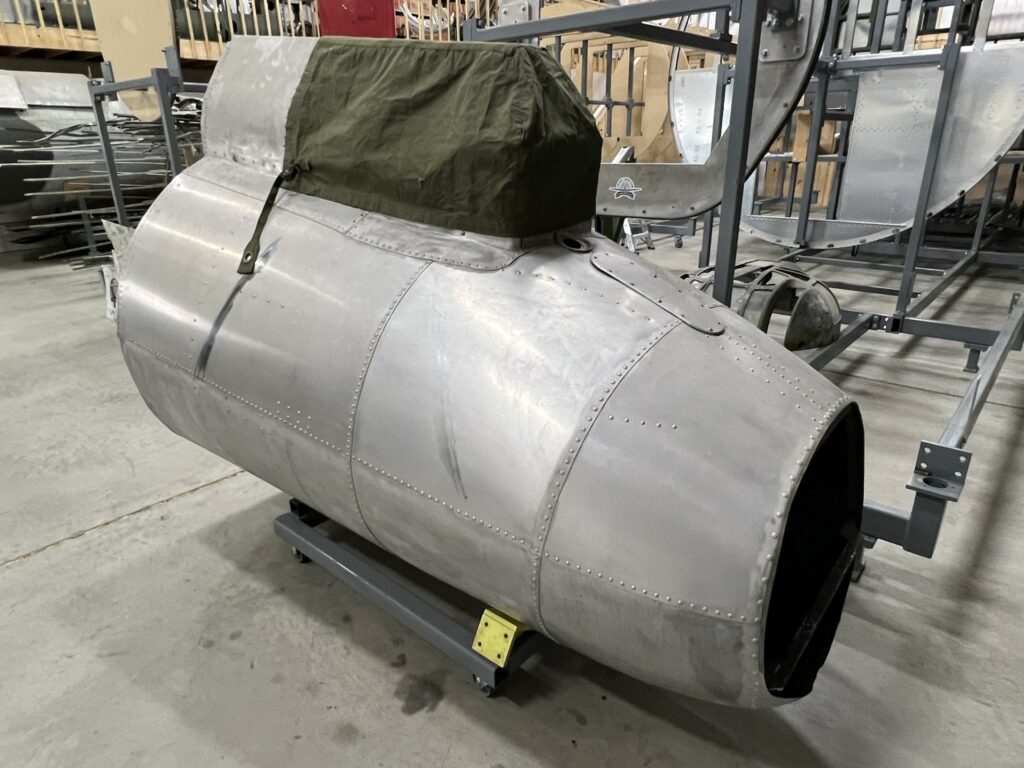
The tail gunner’s rain cover in place on the stinger for Lucky Thirteen.
Photo taken 23 May 2023.
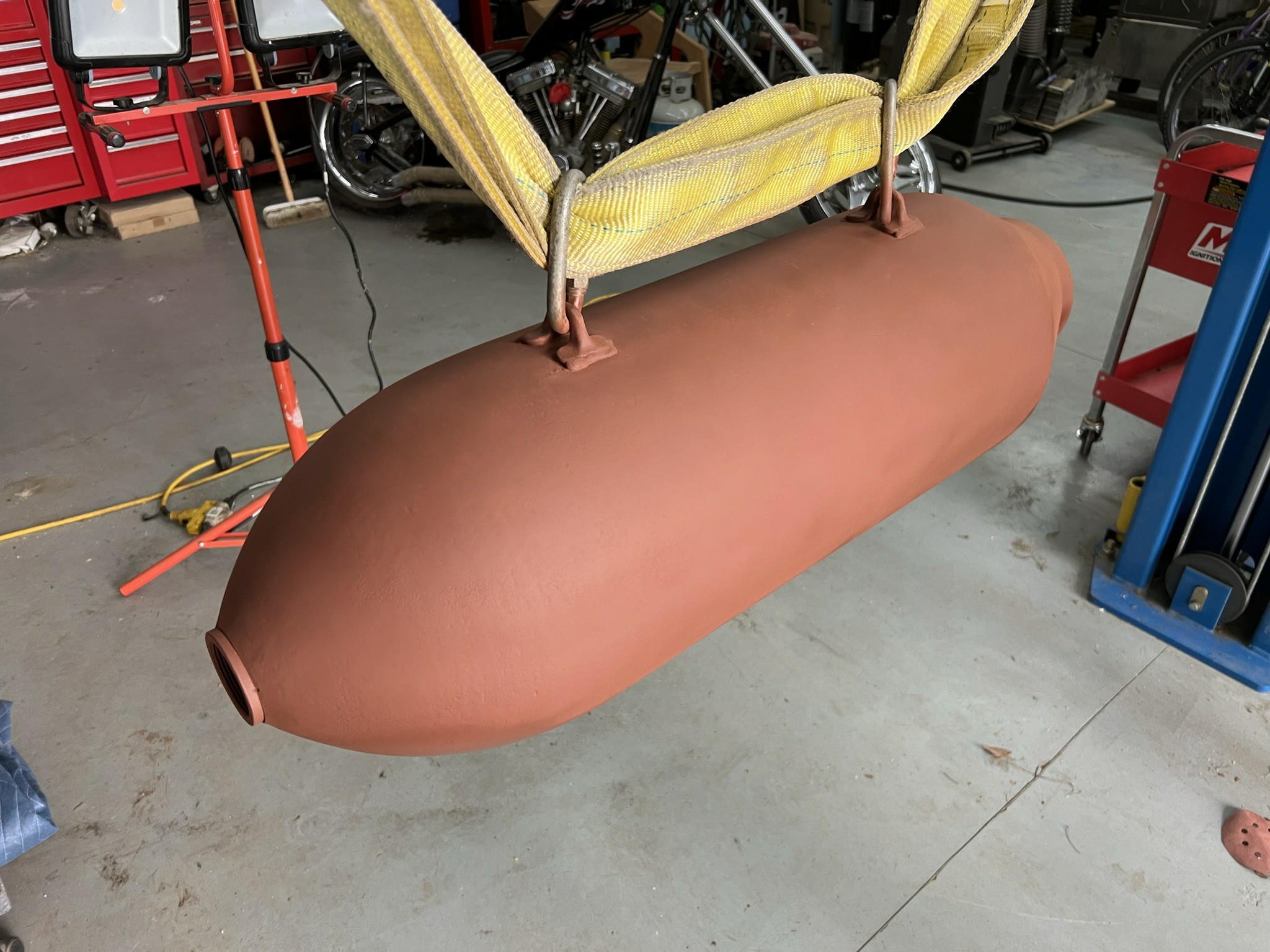
AN-M57 GP Bomb from the New England Air Museum is now rust free and fully primed.
Our friend Kenneth Wade has volunteered to fabricate the missing belly lug from this bomb. This piece is not necessary for use by Army aircraft, but we wish to replace it to be as accurate as possible.
Once said lug is installed, the bomb will be ready for its tail fins and final paint job.
Photo taken 9 May 2023.
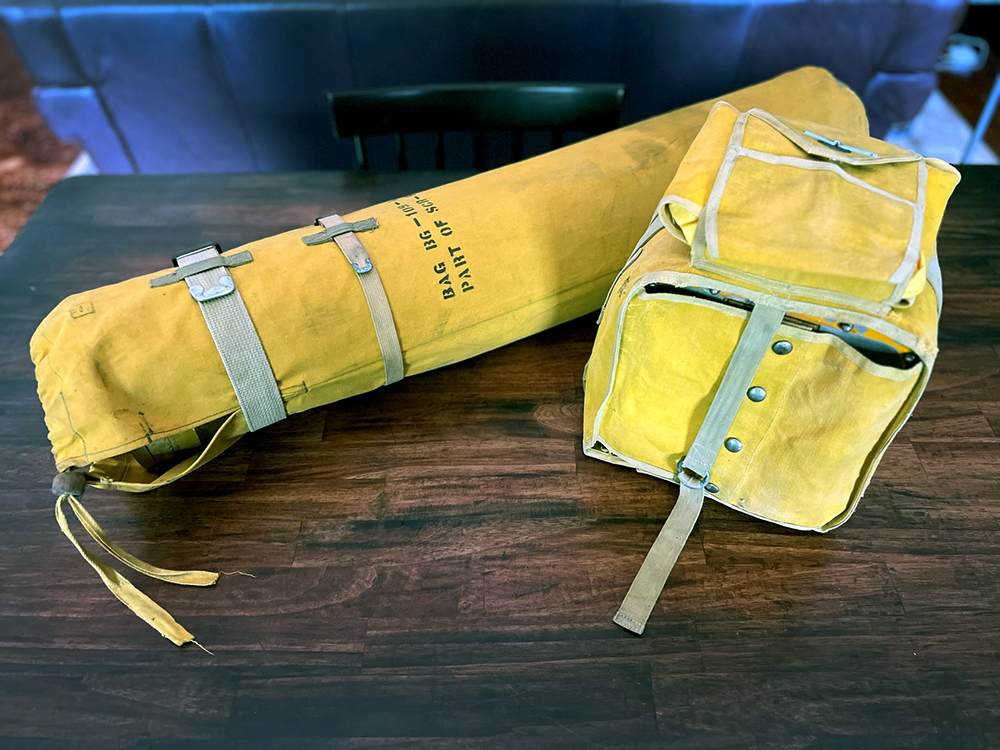
The missing strap from the BG-109 Accessory Bag to the SCR-578-A Gibson Girl Emergency Radio has been replaced.
The strap was hand sewn and dyed to match the original strap below.
It is now ready for display.
Photo taken 4 June 2023.
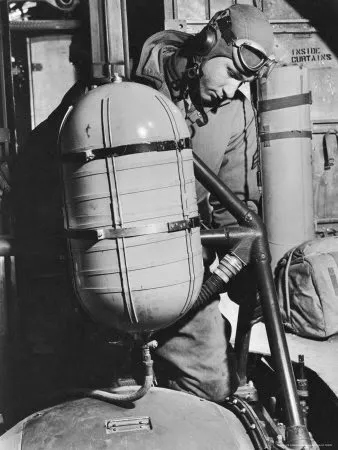
SSGT James M. Abbott, 97BG, adjusts the oxygen bottle that feeds his Type A-2 ball turret. The two early variant Gibson Girl bags are visible behind him.
Thanks to another tank recently donated by our friend Bill Hayes, we are only three Type G-1 Oxygen Tanks away from having a full complement of 18 for Lucky Thirteen.
Some of you may know Karl Hauffe. Karl is, without question, one of the top experts on the Boeing B-17 and having him on the team at Hangar Thirteen is a point of pride for us. He is a good friend and I like to tease him that, if our work can make him happy, then we must be doing something right. Karl and his wonderful wife Judy brought Ron and Carol Batley of the 100BG’s museum at Thorpe Abbots by the hangar for a visit before heading to Savannah.
Taking a short hiatus from the multitude of jobs on our ‘to do’ list, Megan and I followed suit and came down to attend the 100BG reunion too. Presentations were made by the gaming company MicroProse and the “Masters of the Air” production team, with two surviving 100BG veterans being in attendance: CPT John H. Luckadoo (pilot) and 2LT James R. Rasmussen (navigator).
Full disclosure:
Some of you may be aware that we have played a small part in advising on the “Masters of the Air” series, working with our friend Dave Littleton. What is less known is that Karl and I are also advisors for MicroProse in their upcoming series of flight simulators, covering the Boeing B-17, Consolidated B-24, and in one of their releases, the 100BG in particular. And while the talk on the “Masters of the Air” series was done virtually, Andrew Spearin of MicroProse was physically in attendance. So, thanks to the awesome volunteers at the National Museum of the Mighty Eighth Air Force, Karl, Andrew, Hangar Thirteen volunteer Bob Jacoby, and myself were able to crawl around City of Savannah to go over some of the aircraft’s finer details.
We had a wonderful time and it was humbling how many people recognized our project. On several occasions I was met with, “you’re the guy who writes all those super long posts!” Guilty. Ha! The 100BG is a superb organization and the group’s legacy is in good hands with these fine people.
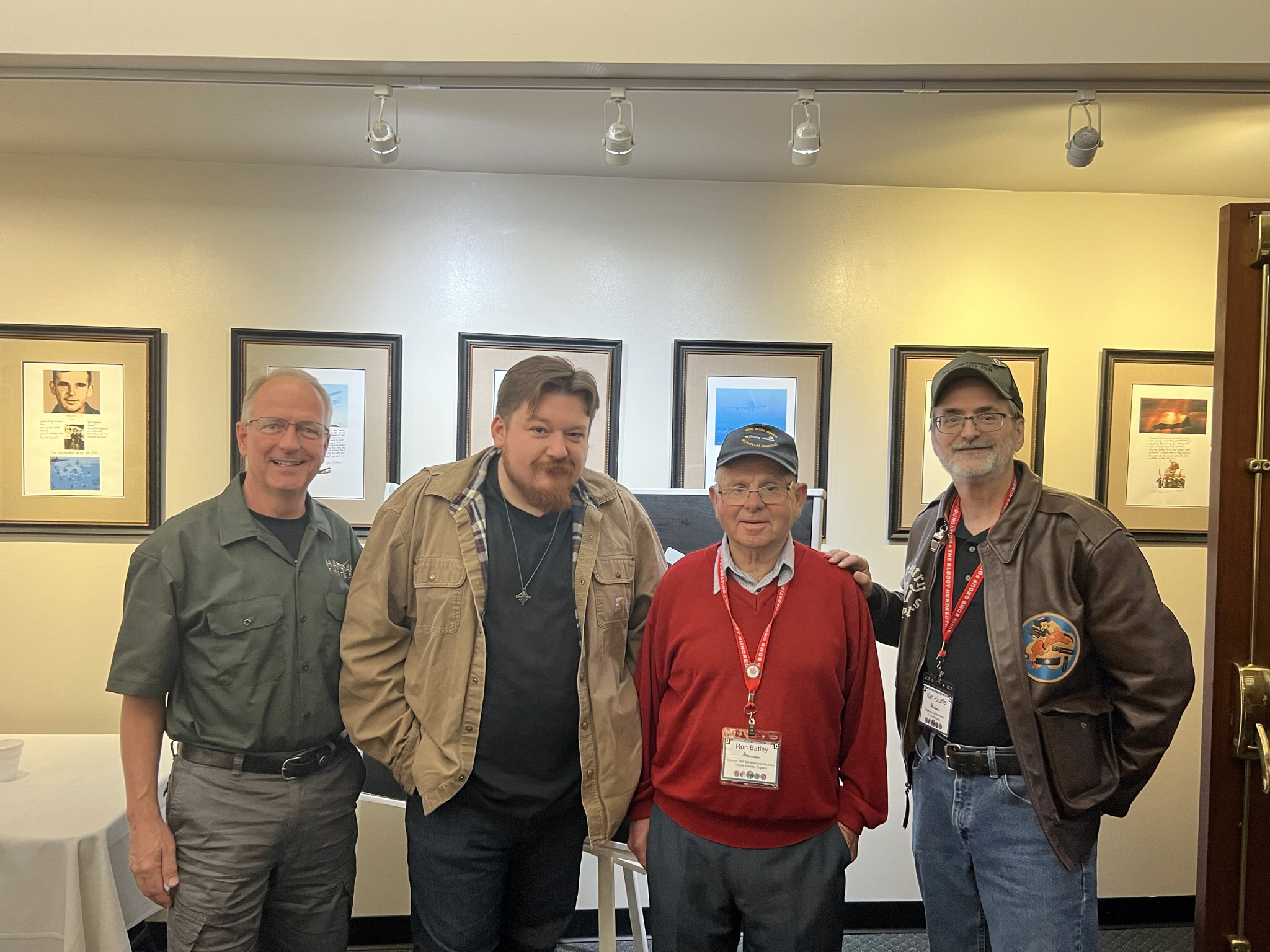
Hangar Thirteen volunteers Bob Jacoby, Gerad Blume (myself), and Karl Hauffe pose with Ron Batley (in red).
Photo taken 27 May 2023.
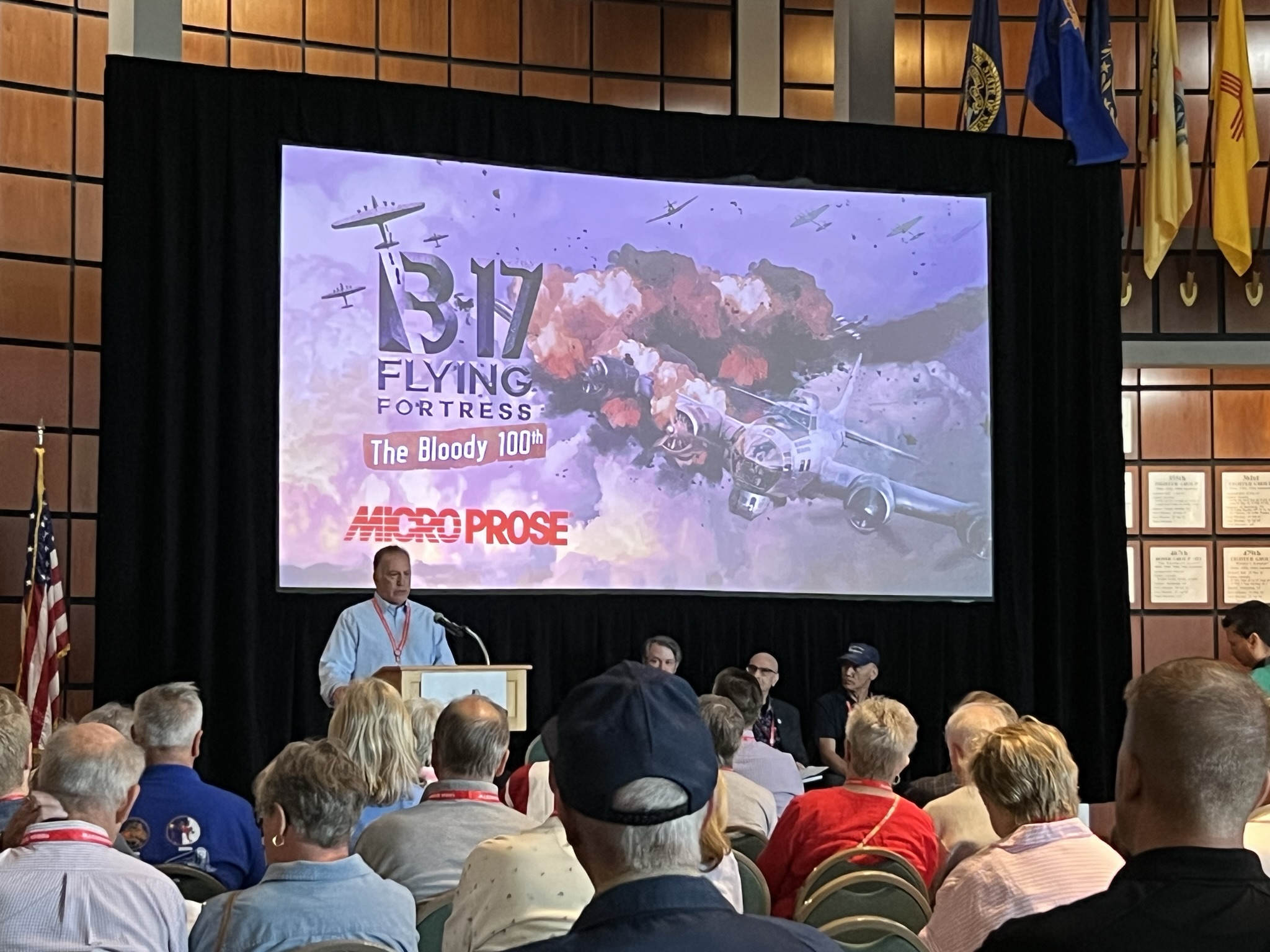
Dan Rosenthal gives an introduction to Andrew Spearin before his talk on MicroProse’s upcoming projects.
Walking up to the stage to chat with Andrew, I was caught off guard meeting Dan. As a historian, it floored me – “you’re Robert Rosenthal’s son!”
Dan, I apologize for my awkwardness.
Photo taken 26 May 2023.
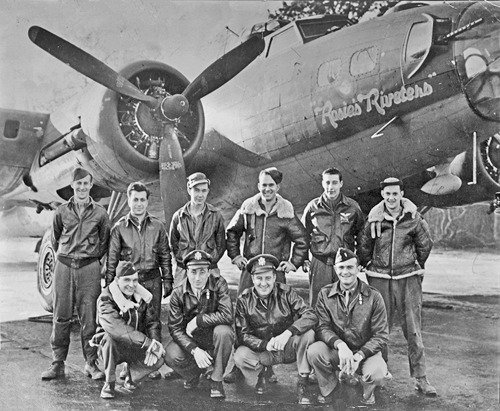
The crew of Rosie’s Riveters (42-31504, 100BG) pose with their aircraft. Rosenthal is on the front row, second from the left.
LTC Robert Rosenthal is a legend in the history of military aviation. On 10 October 1943, his crew, flying Royal Flush (42-6087), were the sole 100BG survivors to return from a strike on Munster. On 10 September 1944, Rosenthal survived the downing of Terrible Termite (42-9777) after a strike on Magdeburg. On 3 February 1945, he led the largest US strike on Berlin, surviving a direct AAA hit that caused “J-Jig” (44-8379) to explode. After the war, he served as an assistant prosecutor at the Nuremburg trials.
And despite all these accomplishments, Rosenthal was renown in the history community for his friendliness and approachability.
Lucky Thirteen was a late-F just like Rosie’s Riveters, being identical in appearance. I sincerely hope that our work does the Rosenthal family proud.

Karl, myself, and Andrew crawling around City of Savannah.
MicroProse is to be commended for going the extra mile in their efforts to research the aircraft, operations, and actual experiences of the US Army airmen in the Second World War.
Photo taken 27 May 2023.
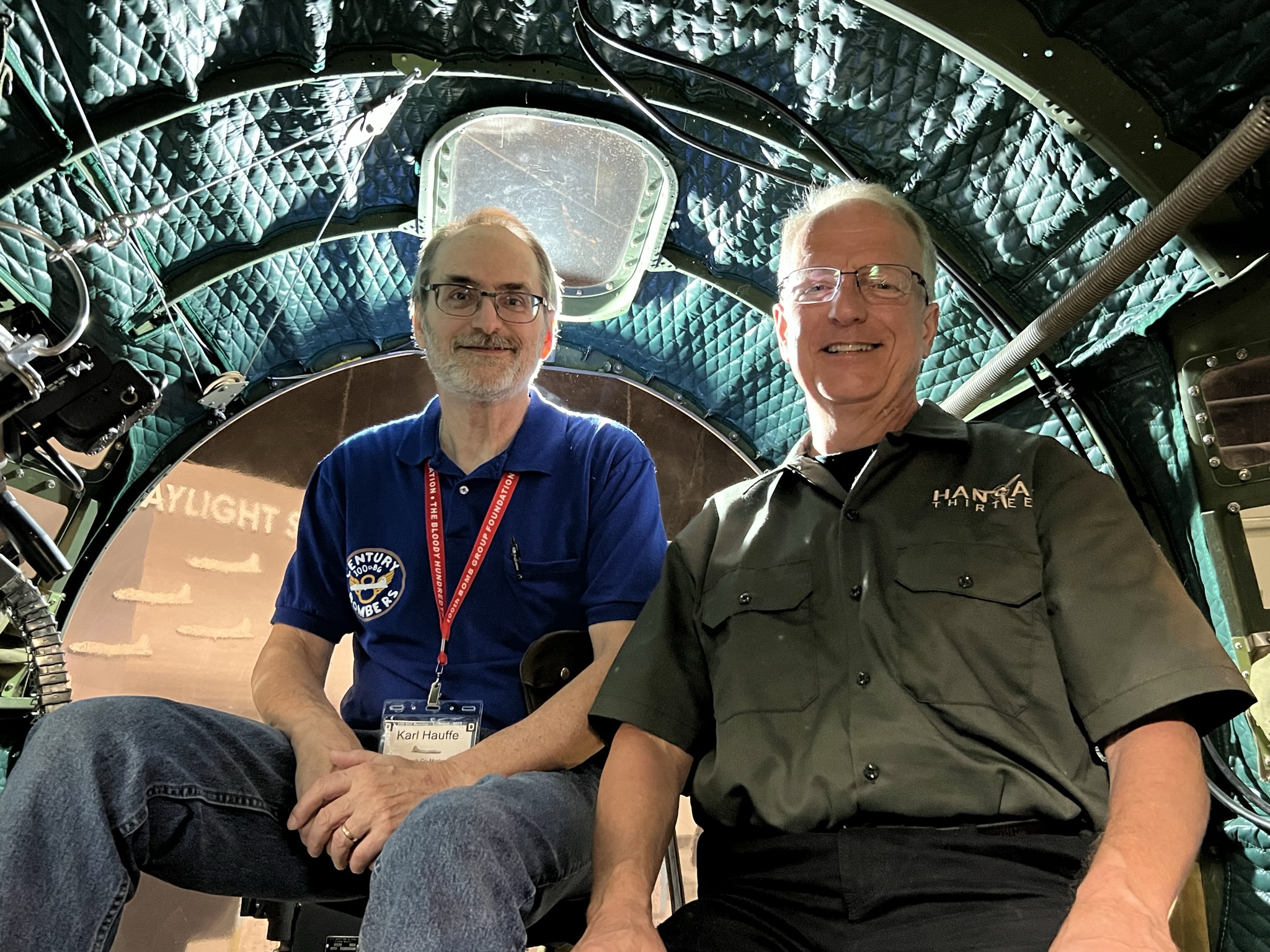
Hangar Thirteen volunteers Karl Hauffe and Bob Jacoby in the nose of City of Savannah.
Photo taken 26 May 2023.

Elizabeth Murphy, daughter of CPT Frank Murphy, gives a live interview about her dad’s excellent memoir, Luck of the Draw.
Murphy’s aircraft, Aw-r-go (42-30725), was lost on the infamous 10 October 1943 strike and Murphy was captured and interred at Stalag Luft III. Several of Lucky Thirteen‘s crew were kept at the same camp, together enduring the death marches of April 1945 at the end of the war.
Photo taken 26 May 2023.
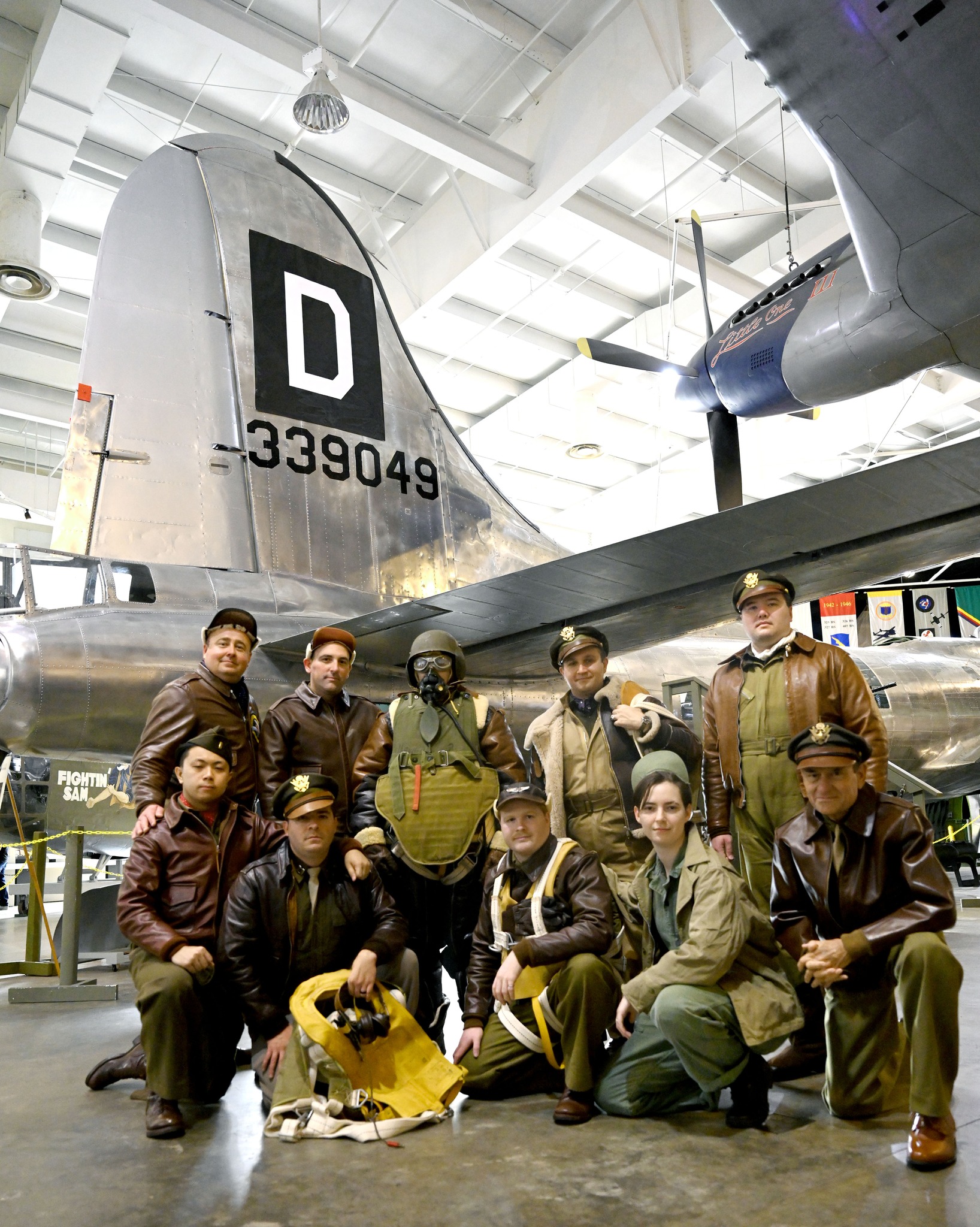
Reenactors pose with City of Savannah.
384BG third-gen Nicholle Sciria, granddaughter of 1LT Edwin S. Halseth, was able to attend on Sunday. Halseth was shot down on 25 July 1943 over Hamburg aboard Passes Cancelled (42-3069, 384BG). These guys were gracious enough to show her the exact gear her grandfather would have worn that day.
Like Frank Murphy, Edwin Halseth was interred in Stalag Luft III and a survivor of the April 1945 death marches.
Photo copied from the 100BG Facebook page.
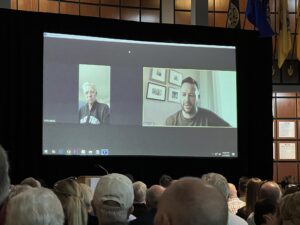
Kirk Saduski and Stuart Heath of the upcoming “Masters of the Air” television series give a virtual Question and Answer session.
Photo taken 27 May 2023.
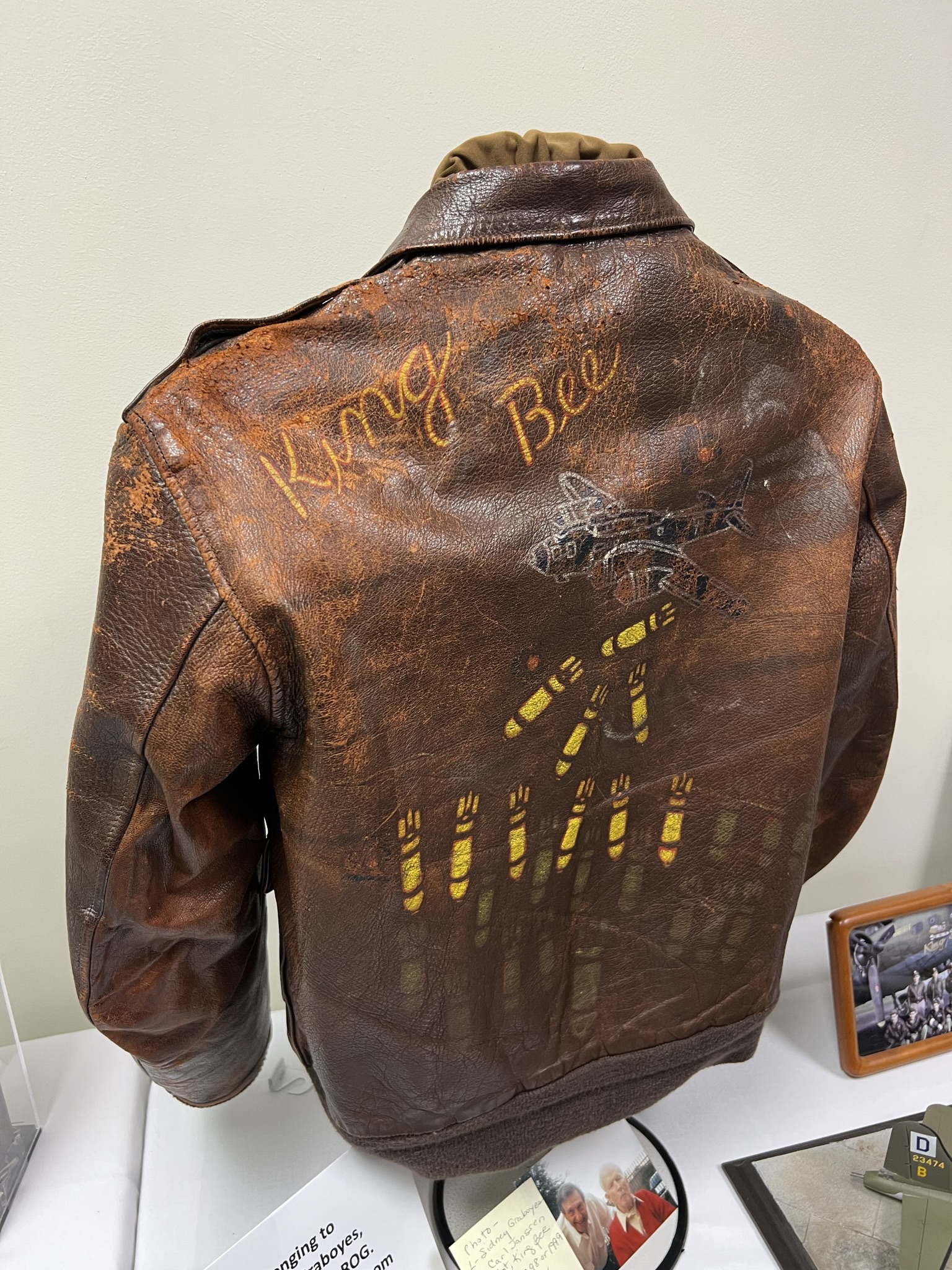
An original Type A-2 flight jacket from King Bee (42-3474, 100BG).
Since King Bee is only a few serial numbers down from Lucky Thirteen (42-3455, 384BG), she is an aircraft whose photos I have studied in depth over the years. Seeing this jacket on display at the reunion was a real thrill.
Photo taken 27 May 2023.
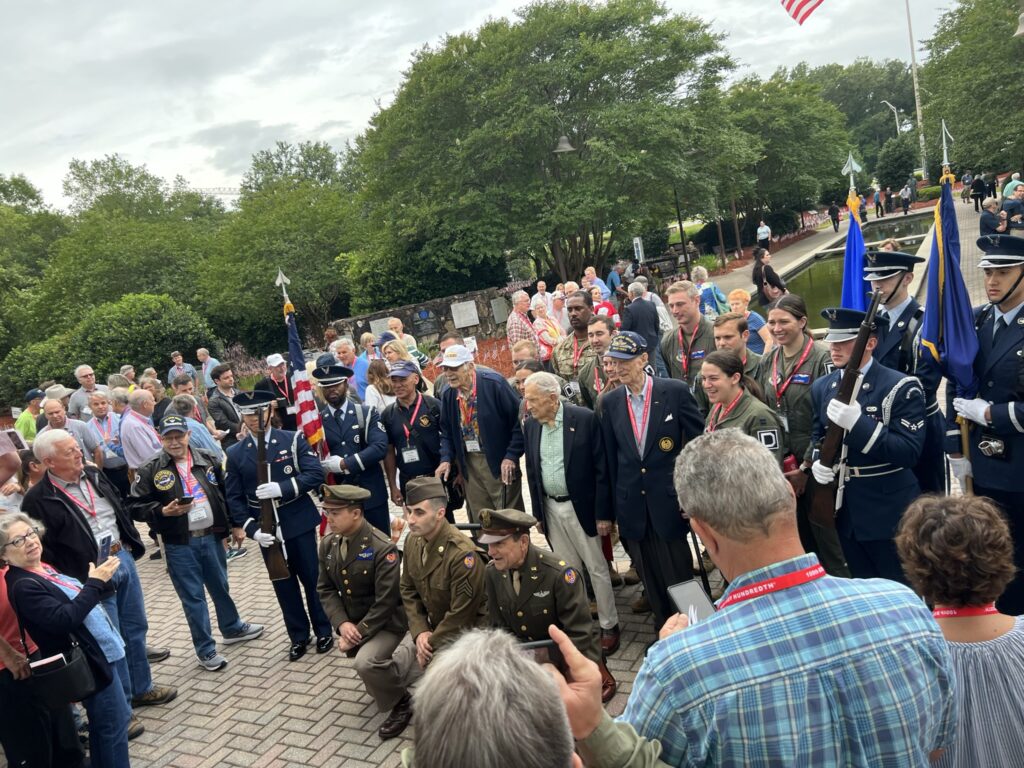
This is what it is all about.
2LT James R. Rasmussen and CPT John H. Luckadoo (in baseball caps) pose with reenactors and servicemen of today’s 100BG.
Photo taken 26 May 2023.
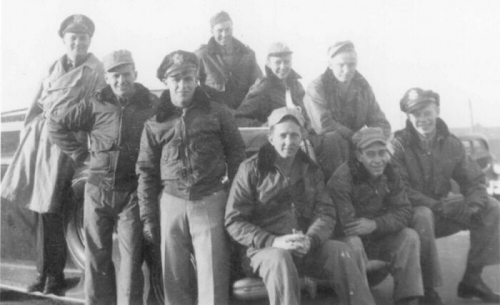
The crew of 2LT Robert W. Wilkes of the 100BG.
2LT James R. Rasmussen is seated on the far right.

The CPT Glen W. Dye crew with Sunny II (42-30796, 100BG). CPT John H. Luckadoo is on the far right. This crew was the first in the 100BG to complete their combat tour of 25 missions, with Luckadoo flying his final mission on 13 February 1944.
Luckadoo was a participant in six of Lucky Thirteen‘s combat missions. This includes her final mission of 6 September 1943 over Stuttgart, in which Luckadoo was co-pilot aboard Sunny II. Sunny II was of an identical design to Lucky Thirteen.
It is our sincere hope that our work makes Luckadoo and his family proud.
A major breakthrough:
Recently, our friends at Desert Rat alerted us to a seller who had NOS examples of wartime CO2 extinguisher brackets. Unfortunately, the seller only had the upper units. So, if we were to mount the extinguishers to the airplane, we were going to have to do something about the lower brackets.
Dave of the B-17G Cockpit Project stepped up to help. He had an original lower bracket and provided us with the measurements to 3D model a replacement bracket. Our team was already hard at work on the extinguishers, with Kevin Davenport and his CAD engineering class at Creekside High School already modeling the A-17’s elbow and horn should it be necessary to replace damaged units.
Using Dave’s measurements, along with blueprint specs for the mounting holes, Howard Lawson of the Virtual WWII B-17G Bomber Project stepped up to model this bracket. Kevin’s class dutifully printed a plastic test model to check the fitting.
I am happy to say that it is a perfect fit! Thanks to Chris Monroe, Dave Littleton, and Howard Lawson, as well as Kevin Davenport and his class at Creekside High School, for digitally recreating this piece. Now that it is in the computer, we now have the ability to create more for future projects.
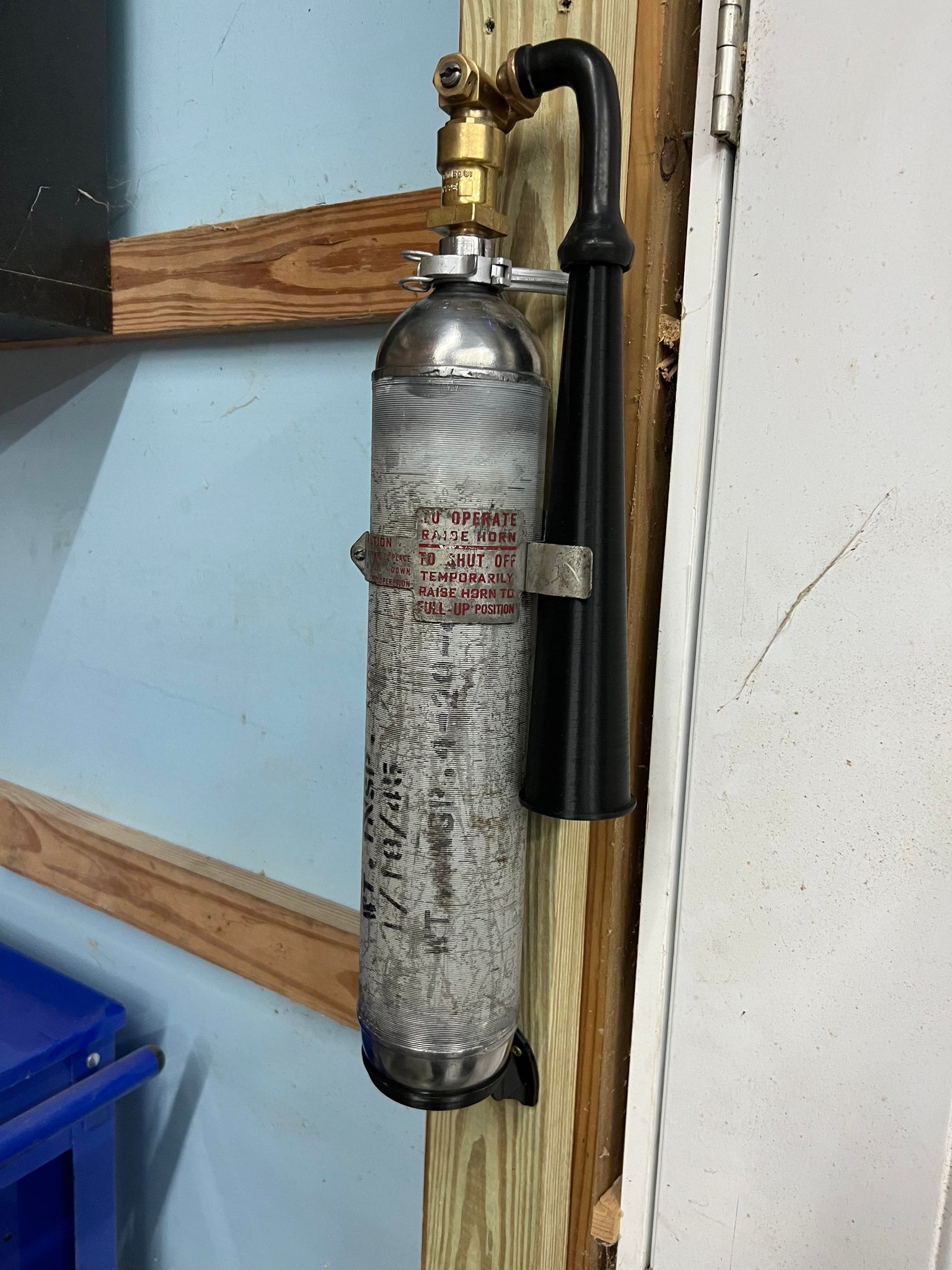
Test fitting the newly created lower bracket with the original upper bracket on the wall of my woodshop.
Photo taken 10 May 2023.
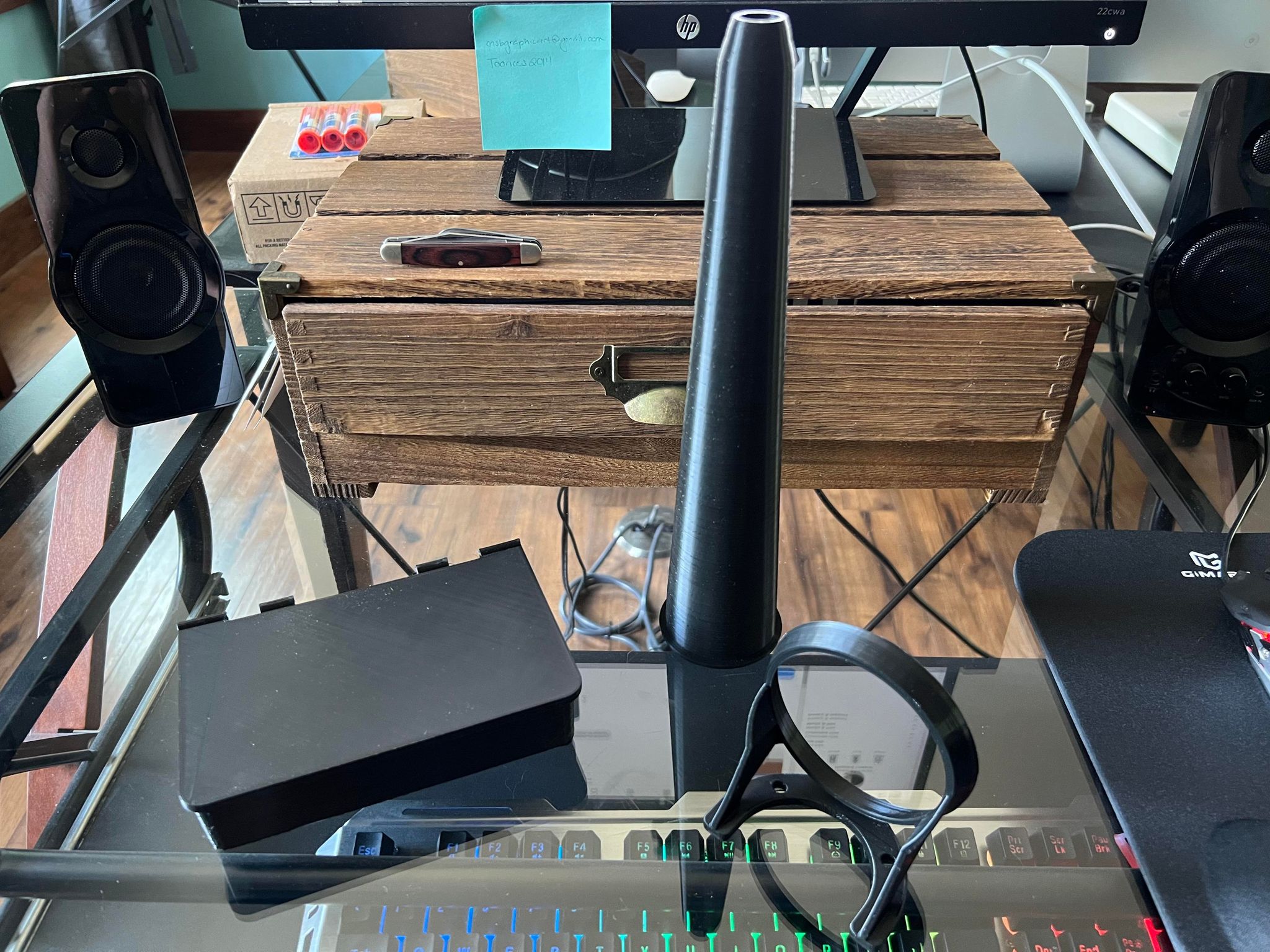
Newly arrived package of 3D test prints from Kevin and his CAD engineering class. The lower CO2 extinguisher bracket is on the far right, with a test printed horn center.
The left most piece is a spare bulbs box. There were three of these on the B-17.
Photo taken 10 May 2023.

Wartime photo taken in the nose compartment of a Boeing B-17F, looking back toward Station 3.
Note the extinguisher here, which is the later 4TB model.
A spare bulbs box can be seen above.
No long write-up for this one.
May is a busy month…
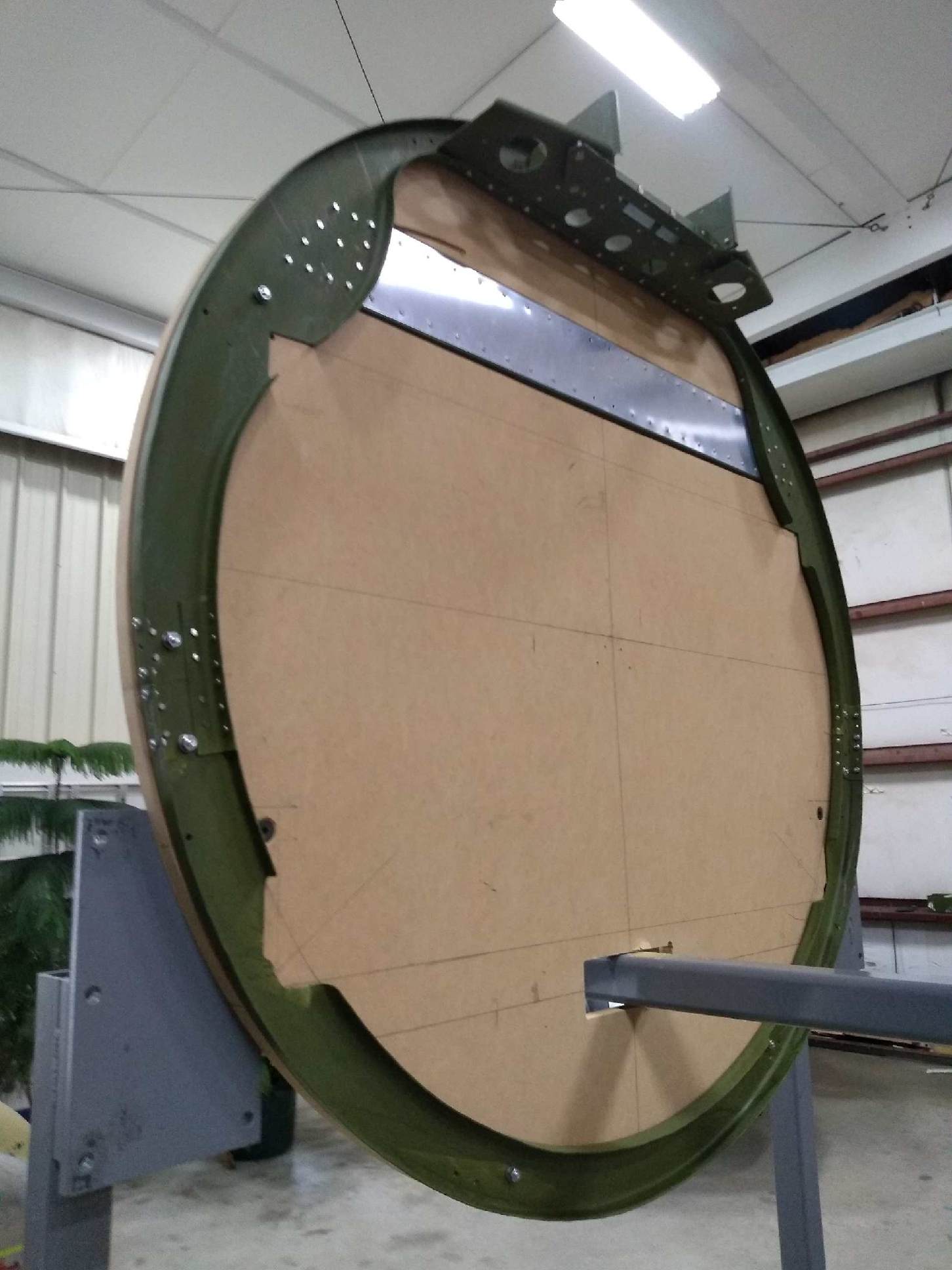
Station 11 of the Lake Dyke B-17 in the jig.
Much of this aircraft’s tail section will come from a Boeing B-17G that was used for nuclear weapons testing.
Photo taken 27 April 2023.

Station 11 to Lucky Thirteen is also being worked on.
Note the triangular piece facing the camera on the left. This piece is unique to Fs and early-Gs.
Photo taken 20 April 2023.

A Boeing employee at work in the tail of a Boeing B-17.
The bulkhead closest to the camera is Station 11. This is where the tail gun assembly attaches.
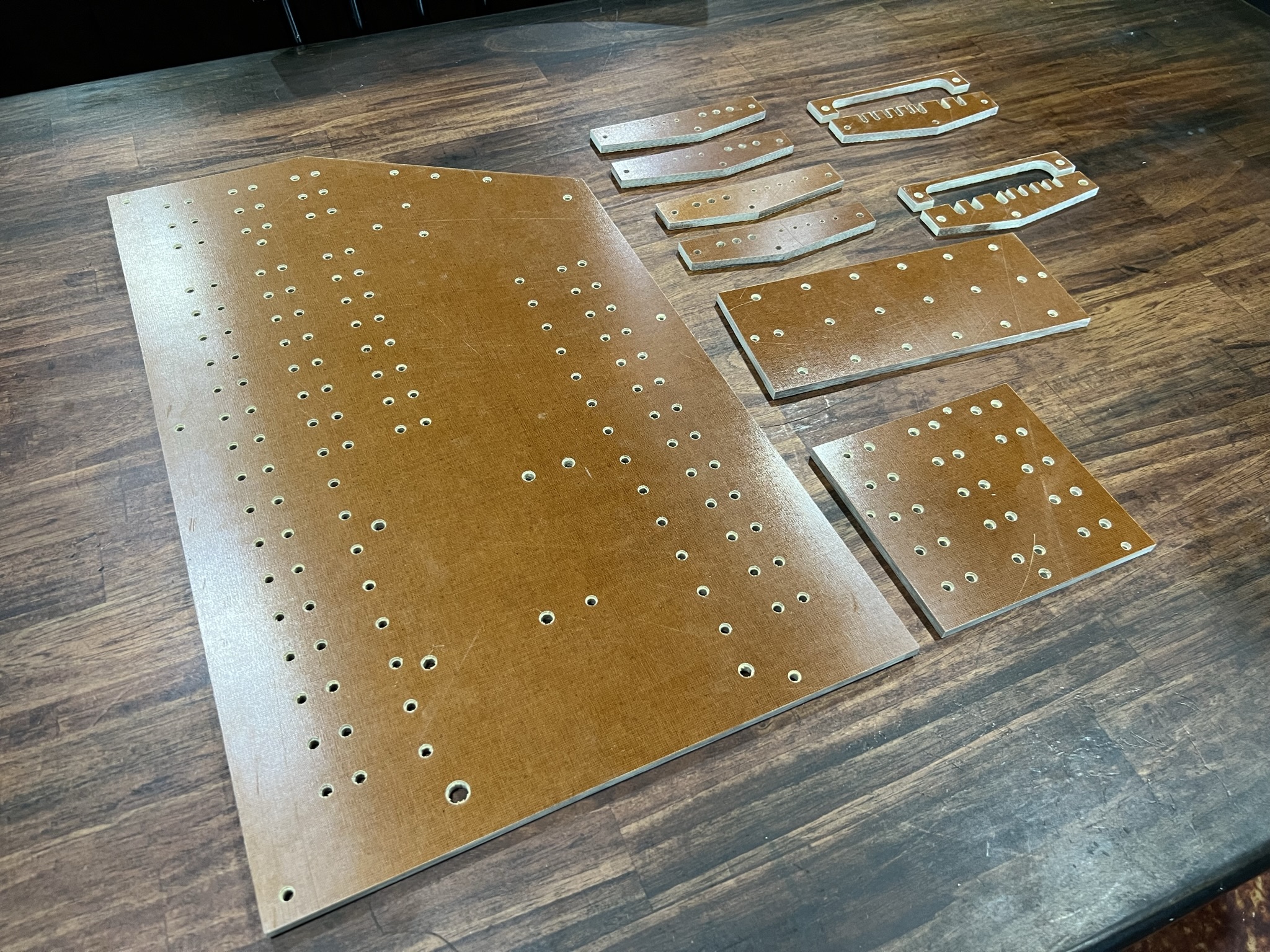
A series of phenolic panels cut for Lucky Thirteen and Liberty Belle.
The largest two panels are for the Station 4 fuse boxes on Lucky Thirteen. Unlike G-models, Boeing B-17Fs had a two-part primary fuse box.
The third largest panel is for the inside of the instrument panel on Lucky Thirteen.
In the upper right corner are carry-thrus for the aircraft’s control cables. The simple designs are F-types for Lucky Thirteen. They stack on top of one another in pairs to fit through the insulation.
The two piece variants are G-types for Liberty Belle.
Photo taken 16 March 2023.
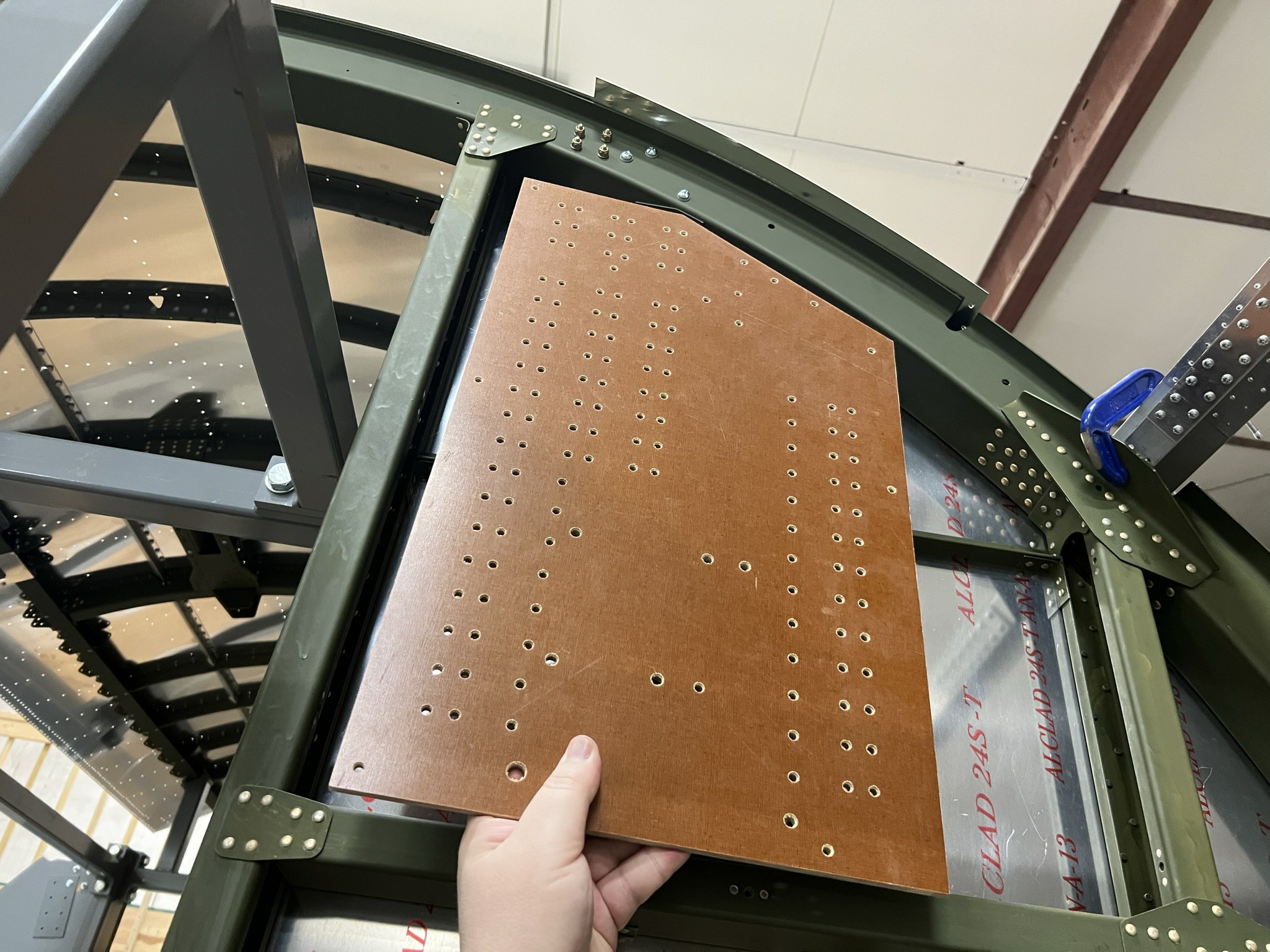
Holding the left main fuse panel where it will go onto Station 4 of Lucky Thirteen.
The tough part of this project will be having the copper buses made for all the fuses which clip here.
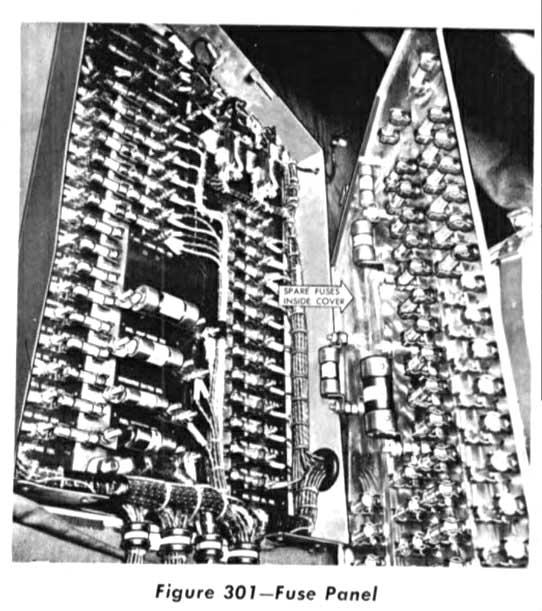
Manual illustration of the B-17’s primary fuse panel.
Note how for each fuse there is a spare mounted to the lid.
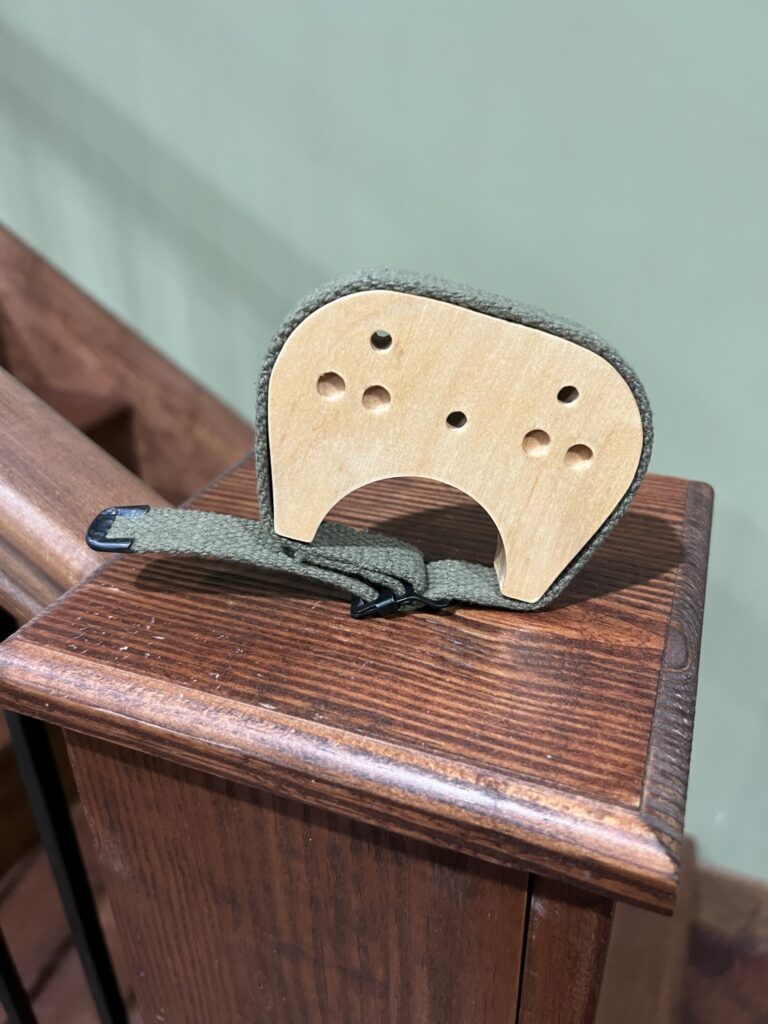

The stowage clamp for the radio hatch gun aboard Lucky Thirteen.
Finding the correct buckles and C-tips to be wartime accurate was not easy – but we pay attention to these little details!
Photo taken 18 April 2023.
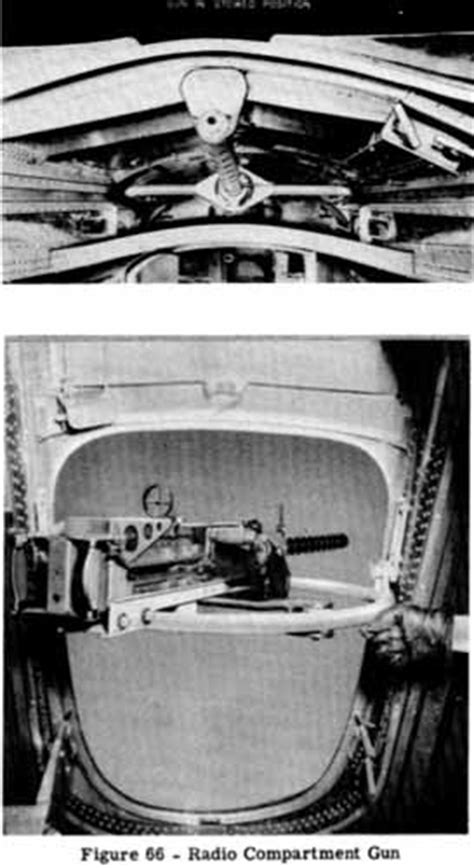
Manual illustration of the two variants of radio hatch guns found aboard Boeing B-17Fs.
The ring type shown on the bottom was installed aboard Lucky Thirteen.
The stowage clamp is visible in the upper picture.

Swiss personnel inspect the radio hatch gun aboard High Life (42-30080, 100BG). Note the straps for the stowage clamp hanging down.
High Life crashlanded in neutral Switzerland on 17 August 1943 during the infamous Schweinfurt-Regensburg strike.
This operation was the third combat mission for Lucky Thirteen.
As some of you may know, Lucky Thirteen was a veteran of the 384th Bomb Group, flying seven combat missions out of RAF Grafton Underwood throughout the summer of 1943. Naturally, this place is special to us. In fact, we are strong supporters of the 384BG Grafton Underwood Museum project, which is cleaning the grounds of the old airbase and establishing a museum via the restoration of the surviving buildings – a truly incredible project!
A few days ago, two of our dearest friends there, Sam Coleman and Paul Teal, contacted us about some parts. Sam’s dad was Quentin Bland – legendary caretaker of the 384BG’s local history – and Sam and Paul have taken up that mantle with their RAF Grafton Underwood WW2 Memories Facebook page. If you have not visited the page, we HIGHLY suggest you check it out!
Amongst the parts that they were asking about was a rare piece from a Boeing B-17 – the armor plate for the cockpit door.
The B-17 was, even by modern standards, a very heavily armored aircraft. When Hptm Egon Mayer and OLt Georg-Peter Eder of JG2 introduced head-on attacks as standard against US heavy bombers on 23 November 1942, the US responded in kind. Not only was this responsible for the unique center nose gun found on Lucky Thirteen, but it also saw Boeing introduce additional armor plate in the aircraft’s forward fuselage.
This piece was one of several mounted on Station 4 (the back wall of the cockpit). Made of .25” thick homogenous steel, this plate was attached to the bomb bay side of the cockpit door.
Few of today’s surviving B-17s retain their armor plating, primarily because of the added weight they put on the aircraft. However, it is our intention to outfit Lucky Thirteen with her full complement of armor plating, as we are uncompromising in our dedication to accuracy.
Sensing our amazement, Paul and Sam offered to contribute this panel to the project. You cannot imagine how much this means to us. Not only is it an original part from a combat veteran, but it comes from RAF Grafton Underwood – Lucky Thirteen’s home. Words can hardly express our thanks. I hope our restoration of this piece, and its installation aboard Lucky Thirteen, makes you proud.
Keep the show on the road!
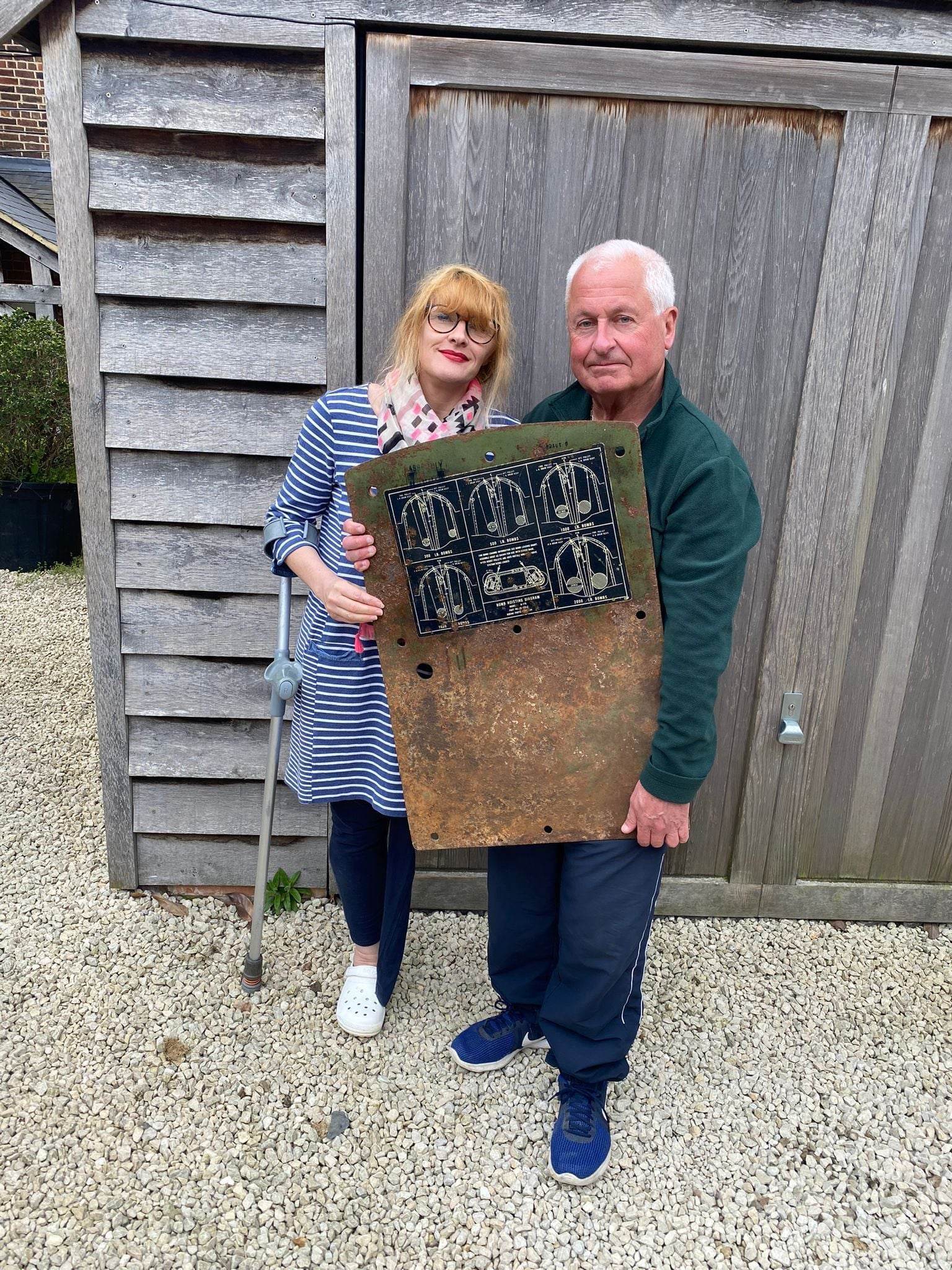
Sam Coleman and Paul Teal pose with the Boeing B-17 cockpit door armor plate.
This particular plate comes from a G-model, as evidenced by its black loading chart. Fs and early-Gs had loading charts made of white cardstock.
Interestingly, this plate has been painted with zinc chromate. This was not standard. Usually, armor plating was painted olive drab.
Photo taken 3 May 2023.

The cockpit door to Lucky Thirteen.
Graphic design is one of our specialties, and we also recreated the charts for Memphis Belle at the National Museum of the US Air Force.
The upper chart is the aircraft’s fuel system. The lower chart is a listing of the system blueprints applicable to the aircraft’s serial number.
The door’s hardware and Flight Reports Folder are original.

Bomb bay side illustration of Station 4 aboard a Boeing B-17F.
The armor plate for the cockpit door is in the center, with the older cardstock type loading chart glued on.
Notice the large armor plate to the left. A similar armor plate could also be found on the right on the opposite side of the wall.
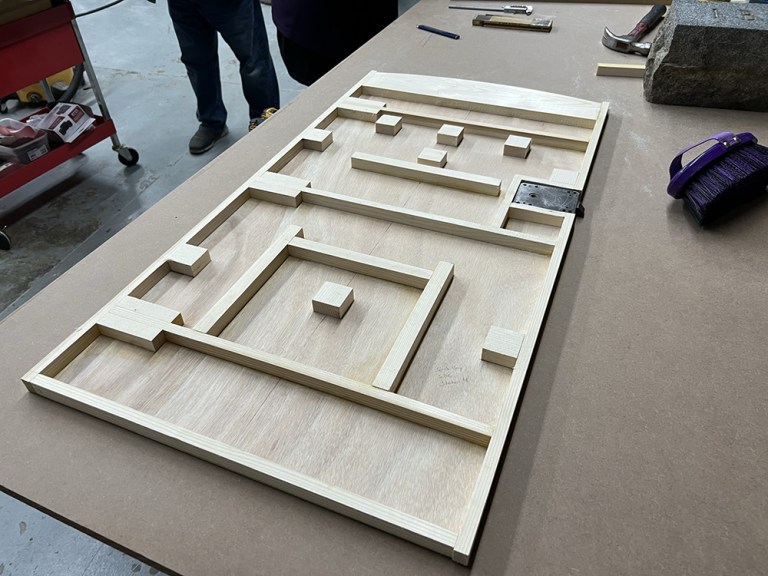
The interior of the cockpit door we made for Desert Rat.
The only changes from the original blueprint was the addition of reinforcements for the arch and hinges. This will ensure the door is slightly stronger than the original design.
The cockpit door is one of the more complex pieces of carpentry on the Boeing B-17. Deadwood is installed for the fuel system and data charts (which were framed on older B-17s), for the armor door plate, and for the Flight Reports Folder.
Photo taken 22 December 2022.
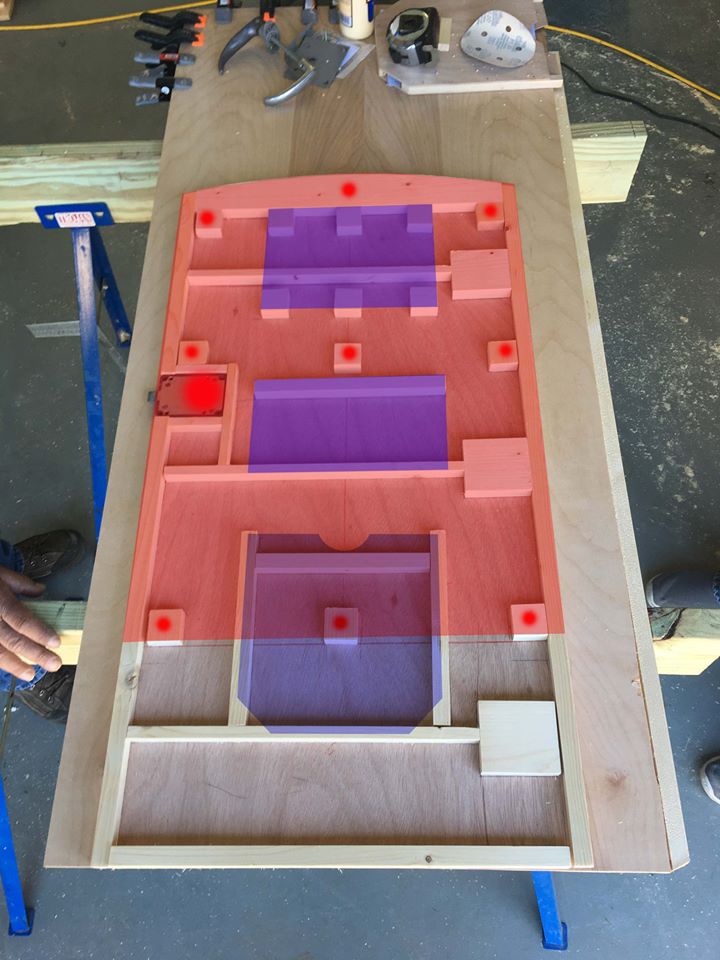
A photo of the Station 4 door’s interior is highlighted to show the purpose of the various deadwood pieces.
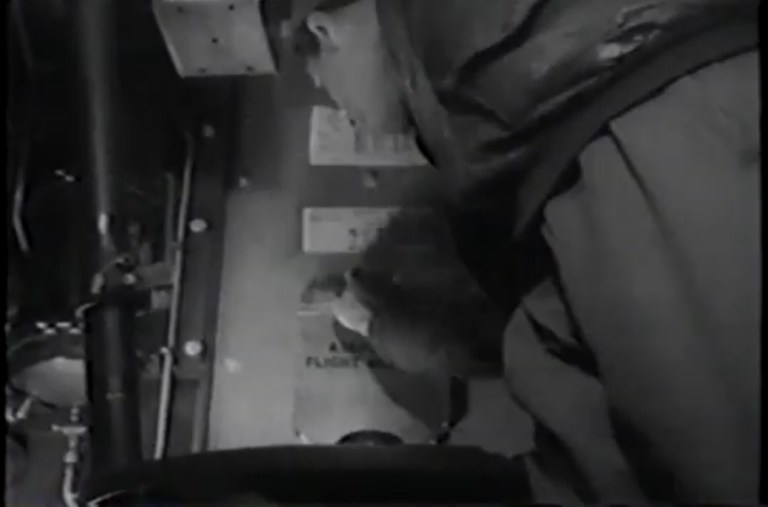
A screenshot from the film “How to Fly The B-17” showing the cockpit door.
Note the bolts protruding through where the armor plate attaches. According to the blueprint, this armor plate weighs just over 43 pounds.
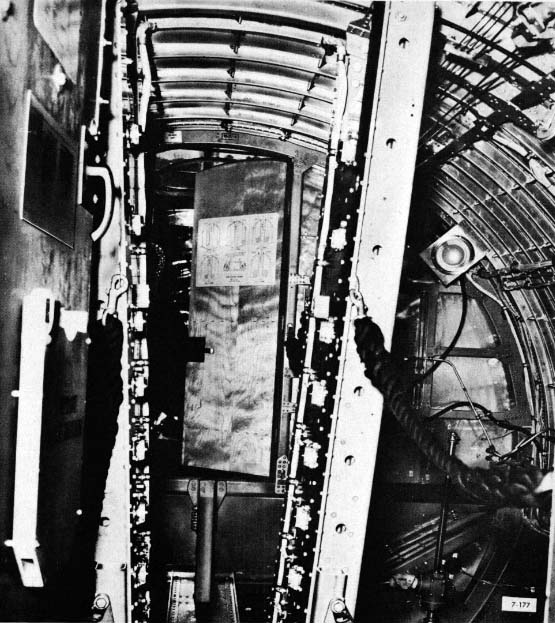
Looking back into the bomb bay of an early G-model B-17 through the cockpit door.
When taking into account the top turret’s chassis and the various oxygen tanks, the cockpit of the B-17 was extremely cramped. As such, there are few wartime photos of this area.
As some of you may know, I (Gerad) do all the carpentry work on Lucky Thirteen, along with my various other responsibilities. Well, recently I completed the wooden portion of the radio operator’s desk for B-17E Desert Rat .
Early B-17 radio tables, up until block F-30, were surprisingly complex. Aluminum channels supported an otherwise mahogany table, topped with a red-brown linoleum. I was able to locate a 1947 catalog from Armstrong (the original supplier) and used the sample inside to color match the original material to a product currently sold by Johnsonite.
At the time, I was advising on Memphis Belle at the National Museum of the US Air Force, and Johnsonite was kind enough to donate an entire roll. I provided the NMUSAF with enough linoleum to outfit both Memphis Belle and Swoose, and we confirmed the color match by comparing the material to the original desk pulled from Belle (which had cigarette burns in the table).
In the case of Desert Rat, I not only provided the linoleum, but I also fabricated the wooden desk assembly. When they pick it up, the Rat’s team will complete the metalwork inside, glue and trim the linoleum, and attach the metal banding.
Speaking of the Rat, they recently provided us with valuable references to aid in rebuilding the bomb rack indicator for Lucky Thirteen.
Located on the bombardier’s panel, the indicator carried a series of tiny 5/16 amber lights, each indicating a release box hard point in the aircraft’s bomb bay. There were 42 said hard points in Lucky Thirteen and the panel assembly included an additional 14 spare bulbs. We were surprisingly able to locate a source for these bulbs and, as such, were able to fabricate the assembly.
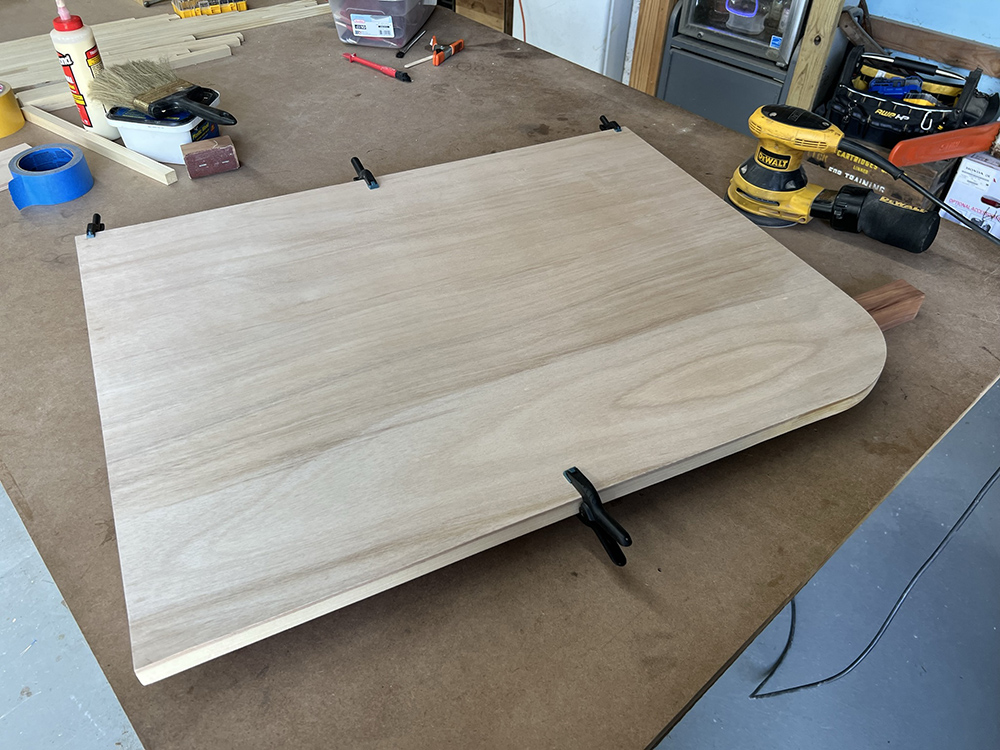
The woodwork is finished for the radio operator’s table on Desert Rat.
The clamps are holding temporary braces until the Rat‘s team completes the metal bracing inside. This will prove challenging, as the channels used were oddball sizes not available on today’s market.
Photo taken 21 April 2023.
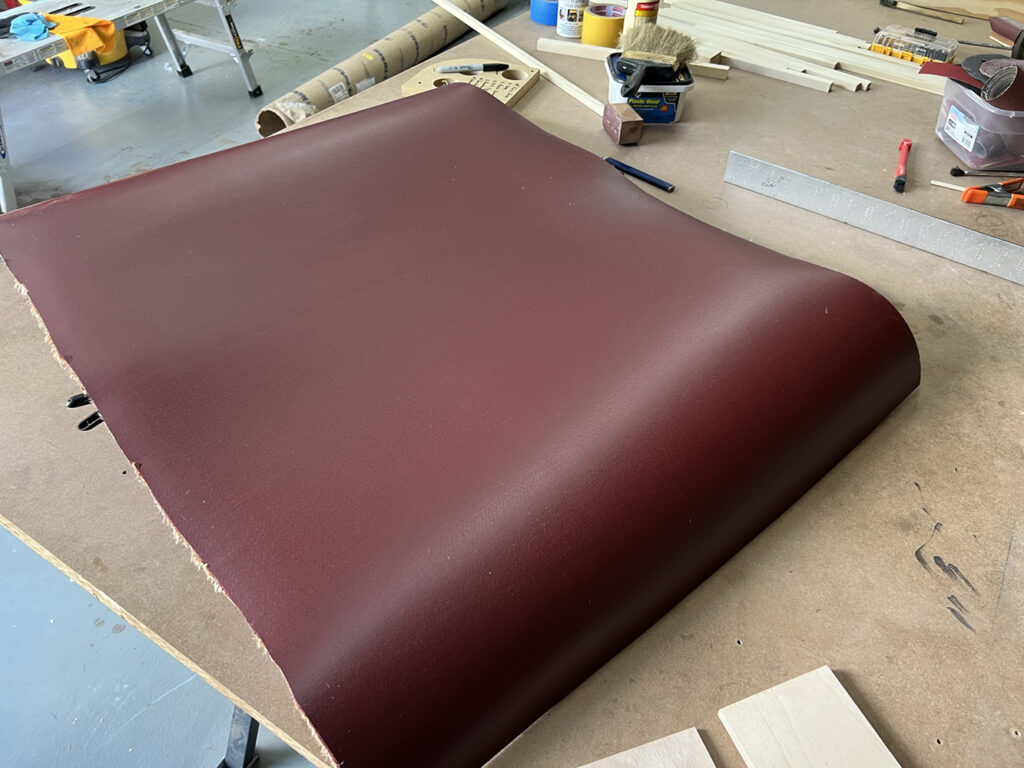
The color-matched linoleum for the radio table that will go in Desert Rat.
At the bottom you can see a pair of wooden squares. These are the front and back to the radio operator’s pencil drawer. These small aluminum drawers will be needed by both Desert Rat and Lucky Thirteen.
Photo taken 21 April 2023.
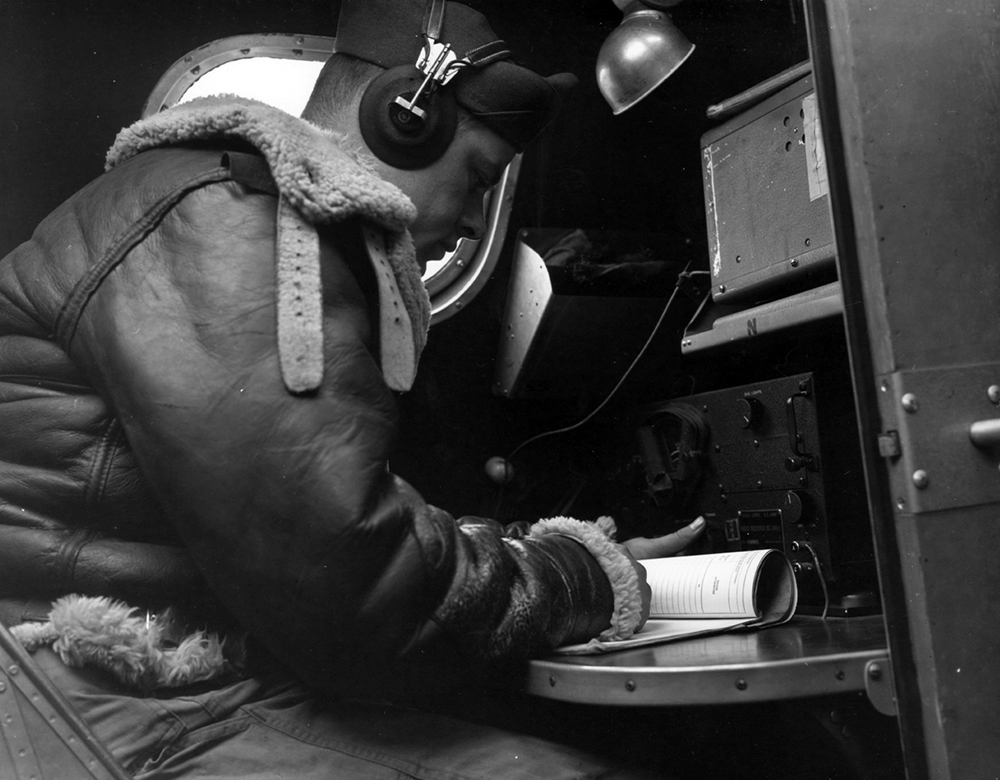
An early linoleum-topped radio operator’s desk aboard an Boeing B-17E.
This picture is usually labelled as showing TSGT Robert J. Hanson aboard Memphis Belle (41-24485, 91BG) but this is not the case. The radio above the desk is a Bendix RA-10, which was unique to E-models.
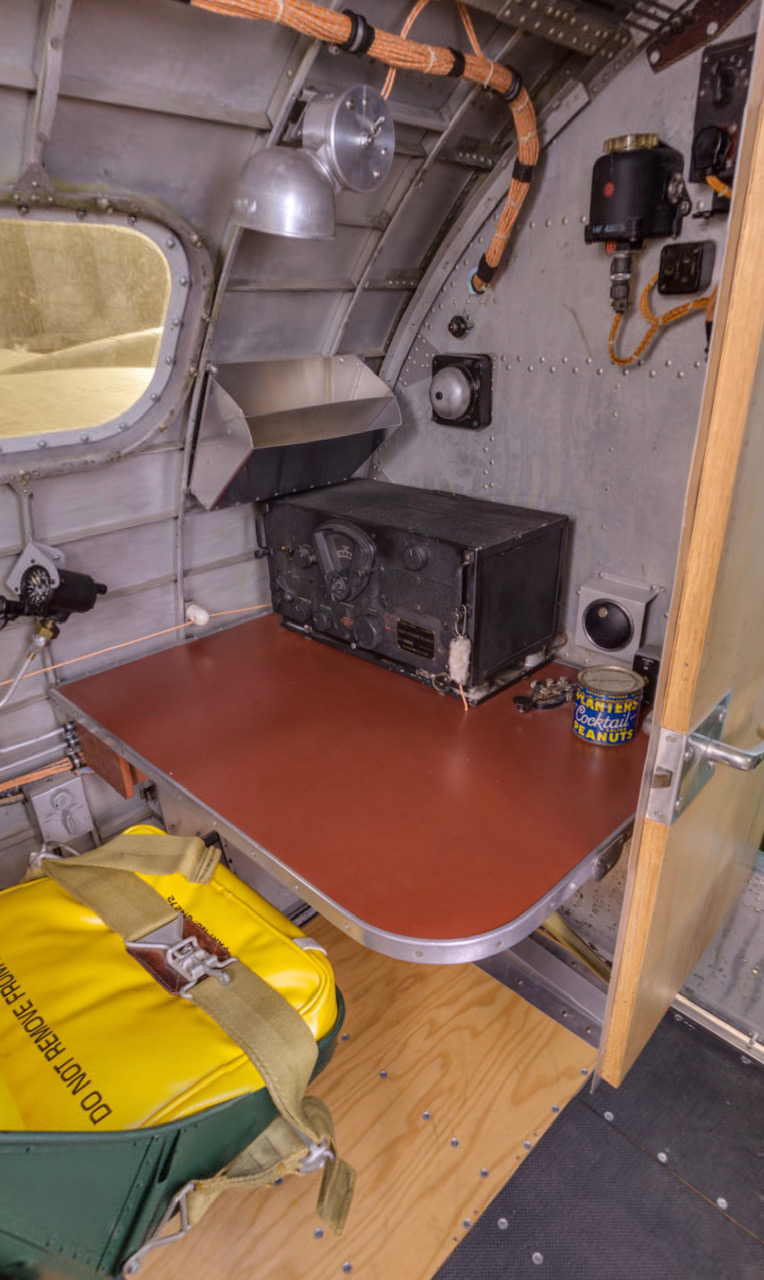
The radio operator’s position aboard Memphis Belle (41-24485, 91BG) as it appears today.
The Planter’s Peanuts can was placed there because a similar can was visible on the desk in the original William Wyler documentary footage.

The navigator’s position aboard Memphis Belle (41-24485, 91BG) as it appears today.
Assuming this is the linoleum we provided, this would mean that they did not keep enough for Swoose.
The arrangement the NMUSAF chose for the Belle‘s nav table is odd. Not only was the Boeing B-17’s nav table not topped with linoleum, but original photos and footage show that the Belle‘s table was a piece of plywood sitting on the opposite wall.

The radio operator’s table for Lucky Thirteen when completed in 2018.
This style table was used on F-model B-17s after block-30 and remained standard for all subsequent Boeing B-17s.
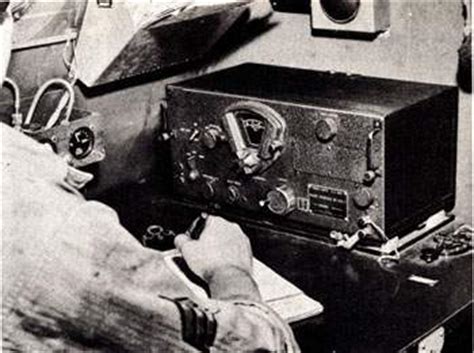
A manual photo showing the later style table installed on a late-B-17F.
Note the dark color. Our research suggests that the tables were painted dark green whenever the compartments were insulated.
This means that, at some point, I need to paint the table for Lucky Thirteen.

The Bomb Rack Indicator Panel for Lucky Thirteen.
Photo taken 8 April 2023.

A manual illustration of a bombardier’s panel aboard a Boeing B-17F. The bomb rack indicator is on the bottom right.
There is a cover plate on which the indicator assembly will attaches. If you have an original, or would be interested in fabricating a new one, just let us know!
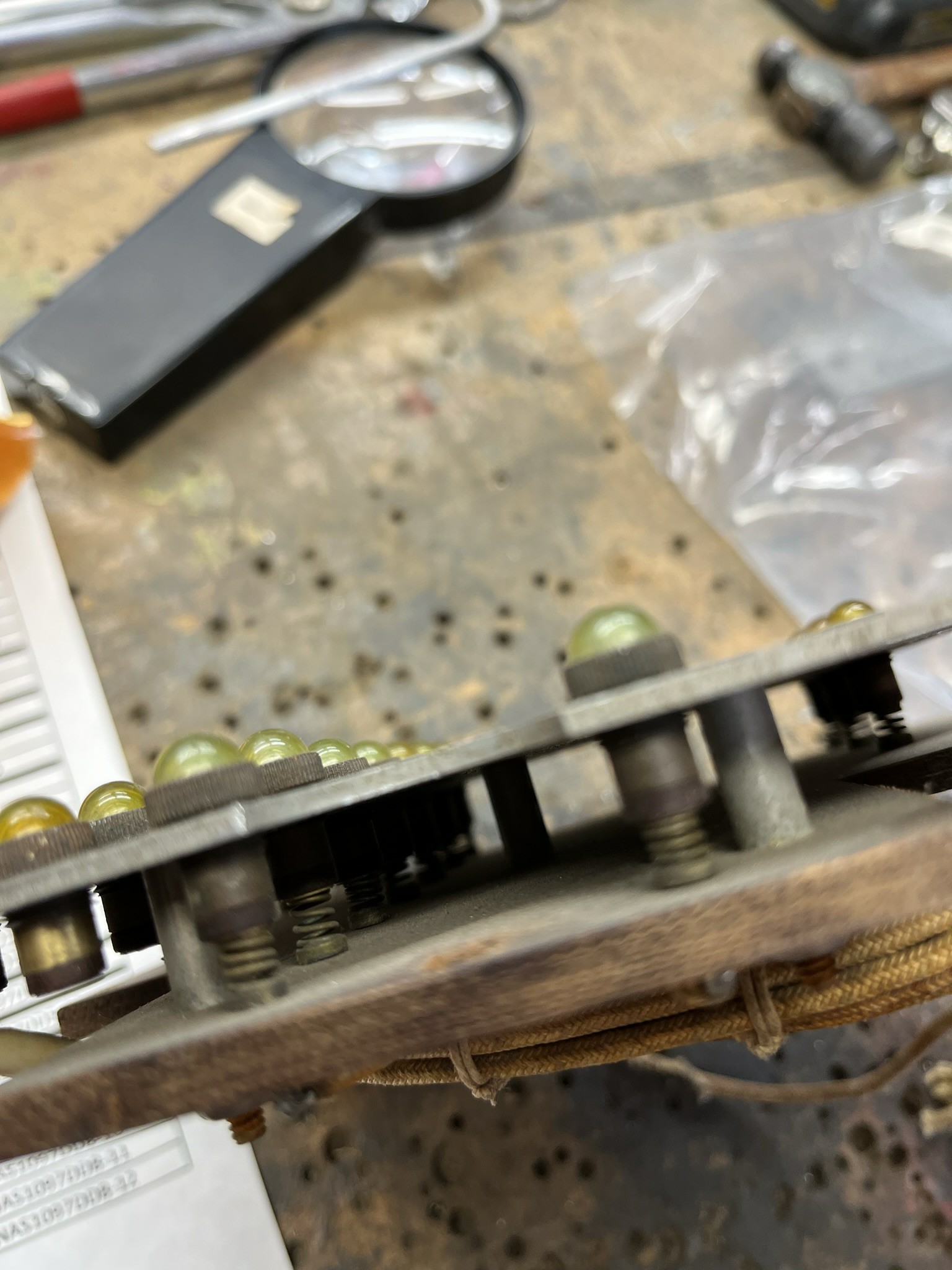
Reference photo provided by Desert Rat showing the lights pushed up against the elusive contact assemblies.
Photo taken 25 March 2023.
In our update about Visiting the New England Air Museum we mentioned a couple special acquisitions. Well, here they are:
We have gotten our first bombs for Lucky Thirteen.
These are a 250 lb AN-M57 GP and a 100 pound AN-M47 chemical bomb.
We have long talked about what a future Hangar Thirteen museum facility might look like, and one of the things that I have pushed for is a display covering WWII US ordnance. It is not a pleasant subject, but that is precisely the reason I feel so strongly about it – it was, after all, war. And having a lineup of the various bombs carried by US heavy bombers is an important educational ideal. This is first step in that direction.
Because the US did not have a Department of Defense during the war, weapons acquisition was split between the Navy and Army (War Department). As such, for a time, bombs from the two services could not be intermixed. For example, while Army bombs had two lugs, Navy bombs only had one (as was the practice with Great Britain). The Roosevelt administration’s Army-Navy Board attempted to smooth this issue by commissioning bombs with two lugs on one side and one lug on the other. Our recently acquired AN-M57 250lb General Purpose is one such explosive, replacing the old Army AN-M31 300 lb bomb.
GP bombs were painted olive drab with yellow bands, the number of bands indicating the bomb’s composition: one band for TNT, two for Composition B, and three for Tritonal. Fully loaded, the Boeing B-17’s internal complement was 6,000 lbs, with a pair of external racks giving the option for an additional 8,000 lbs. It should be noted however, that weight affected aircraft performance, and since altitude added security, external loads were rarely carried. For comparison, the Consolidated B-24 could carry 8,000 lbs internally and the Boeing B-29 an incredible 16,000 lbs.
Since Britain’s Royal Air Force based their strategy on area bombing, tonnage was more important than accuracy, and their aircraft reflected this. The Handley Page Halifax and Avro Lancaster both carried an average internal load of 7,500 lbs and 12,500 lbs (respectively) for example but had service ceilings nearly 10,000 feet lower than their US counterparts. Operating at night helped to compensate for the additional dangers found at these somewhat lower altitudes.
Unlike the AN-M57’s cast steel, the AN-M47 chemical bomb is made of sheet metal, making it MUCH easier to carry around (we loaded that 250lb GP bomb using good old-fashion muscle). Painted light gray, the AN-M47 was a multipurpose casing, with colored bands indicating its contents: green for gas, yellow for smoke, and purple for incendiaries. The US Army Air Forces never operationally used gas, though the latter fillings saw extensive use. Smoke bombs were used by radar-equipped Pathfinders to mark targets, a practice which began on 1 November 1943. Mounted in place of the ball turret, the H2X radar would estimate the position of the target in times of bad weather, marking the target for other aircraft by dropping smoke. By the end of the war, nearly 61% of all US bombs dropped on Germany were following radar Pathfinders, though only 8% came within 1,000 ft of their intended targets. No US wartime bombers today have been restored as radar carrying Pathfinders, though two surviving B-17s actually saw service as such – one as a trainer and one operationally.
The AN-M47’s use as an incendiary is better known, particularly in conjunction with the filler napalm. Traditionally, US operations over occupied-Europe focused on traditional explosives, with incendiaries and delayed-fused bombs being used to dissuade the prompt repair of damaged targets. Over Japan the opposite was true, as tests at the Dugway Proving Grounds showed the violent impact incendiaries had against Japanese dwellings, and such weapons were used acknowledging that Japan did not separate industrial districts from residential ones – targeting the civilian population in much the same way that Britain did against Germany. While most of the incendiaries dropped over Japan were cluster types, the US 20AF dropped so many incendiaries so fast in 1945 that they also used up all their AN-M47s, having to pause in mid-March ostensibly because they ran out of incendiaries to drop.
US stocks of GP and chemical bombs were so high that they saw regular use throughout the next thirty years, with US bombers still dropping WWII surplus bombs late in the Vietnam War.
These bombs were acquired from the NEAM in an anticipation of a future equipment donation that I am sure everyone will be thrilled to see…
A third bomb – a 1,000 pound semi-armor piercing was – was offered to us but left behind because we could not get it down! (Maybe next time…) Both the AN-M57 and AN-M47 will require restoration. The GP bomb is quite rusted and will require a new tail fin. Longtime friend Kenneth Wade has volunteered to restore the missing Navy/RAF lug on the bomb’s opposite side and is currently working on this effort. The incendiary has a bad dent in its nose and its mounting bands are not correct.
War Relic Replicas has generously provided us with the information necessary to restore these pieces. They have also quoted us for replacing the missing parts – 160 USD for the incendiary and 285 USD for the GP. Said quotes do not account for fuses, which are quite expensive. We could sure use the help of our supporters here…
If you would like to support us, either in specifically restoring these bombs, or with our work rebuilding the Boeing B-17F “Lucky Thirteen,” please let us know. Donations are particularly helpful in these trying times – and the more you support us, the more we can accomplish! Our PayPal address is Store@HangarThirteen.org and physical donations are best sent via my home address, which is:
Gerad Allen Blume
VP, Hangar Thirteen Foundation
442 Old Chalk Bed Road
Batesburg, SC 29006
Whenever writing out to us, as on a check or our PayPal address, be sure to check your spelling, particularly of the word “Hangar.”
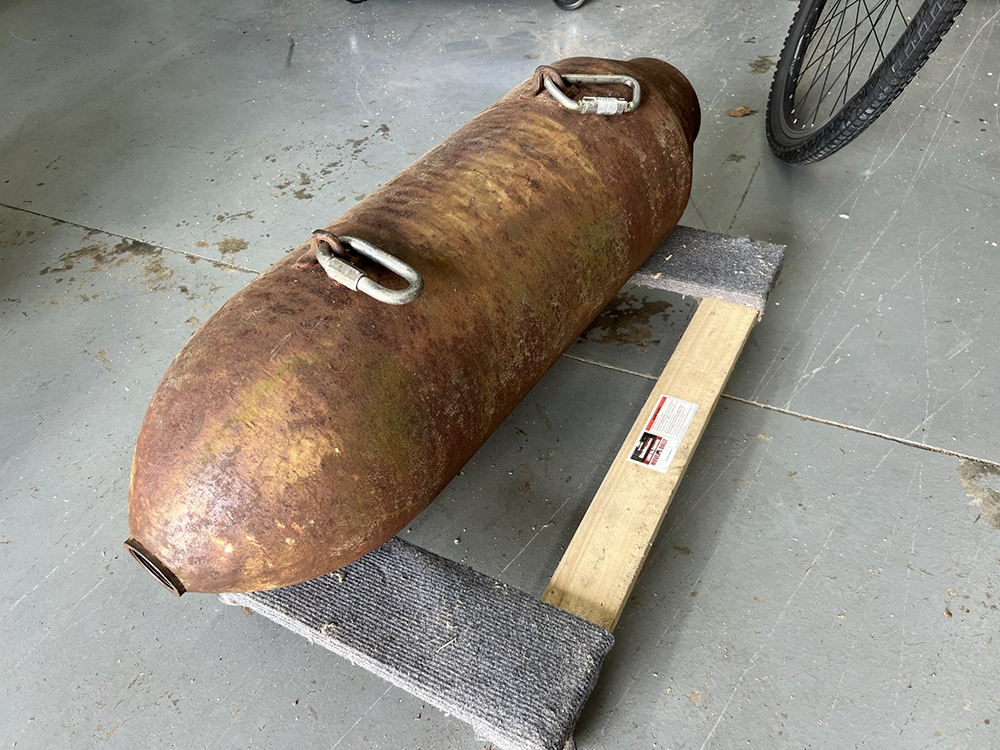
The recently acquired AN-M57 250lb GP bomb. Admittedly, it feels much heavier than that…
The loops were clamped on to help move it about, as was the piano moving cart.
Special thanks to Eric Miller of Project Warbird for his help with acquiring this piece!
Photo taken 3 April 2023.
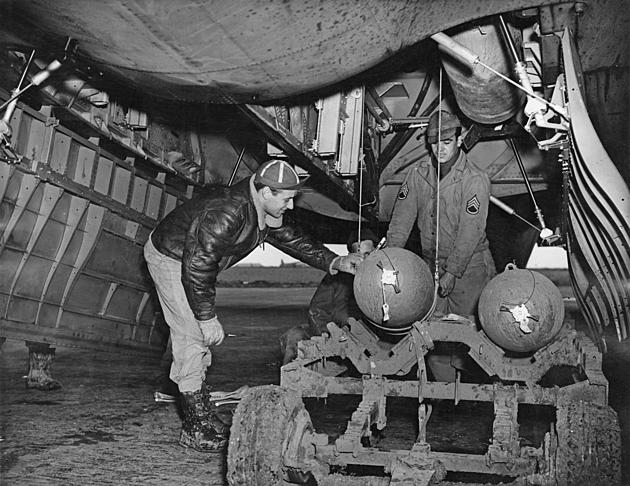
Armorers load a Boeing B-17F with AN-M31 300 lb GP bombs.
Photo taken 18 December 1942.
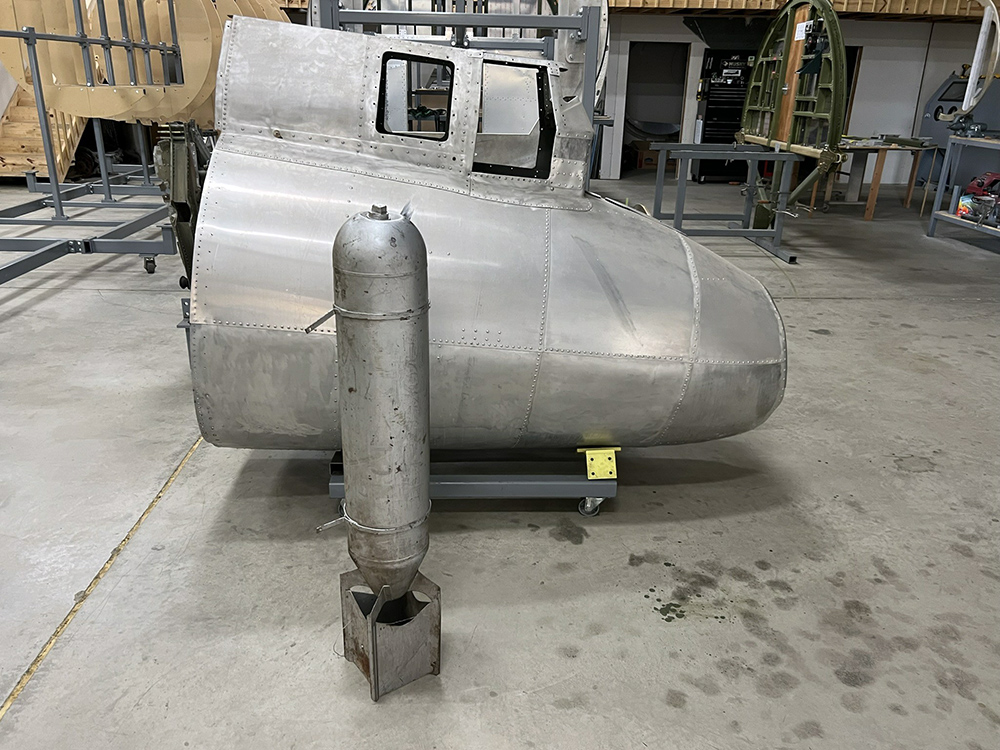
Hangar Thirteen’s AN-M47 chemical bomb next to the tail gun assembly for Lucky Thirteen.
Special thanks to Eric Miller of Project Warbird for his help with acquiring this piece!
Photo taken 23 April 2023.
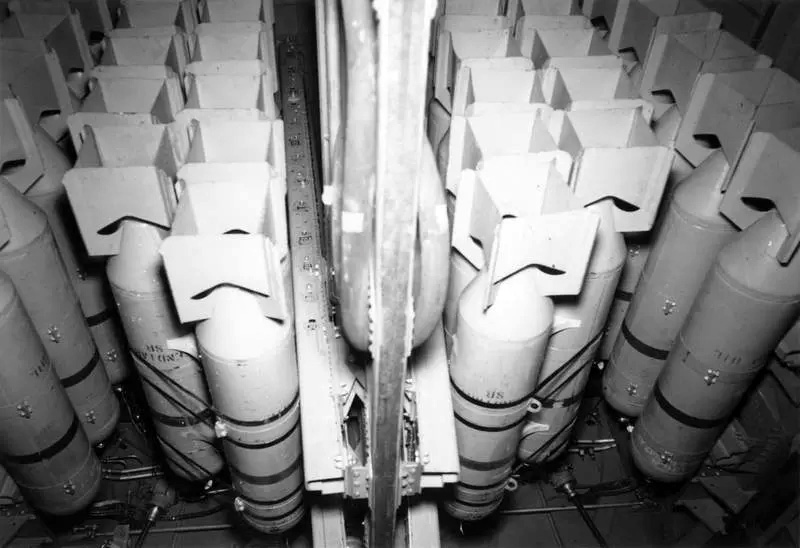
A Boeing B-17F loaded with AN-M47 incendiaries. Note how extra rows of bombs have been doubled-up on the center ranks.
Photo taken 3 June 1943.
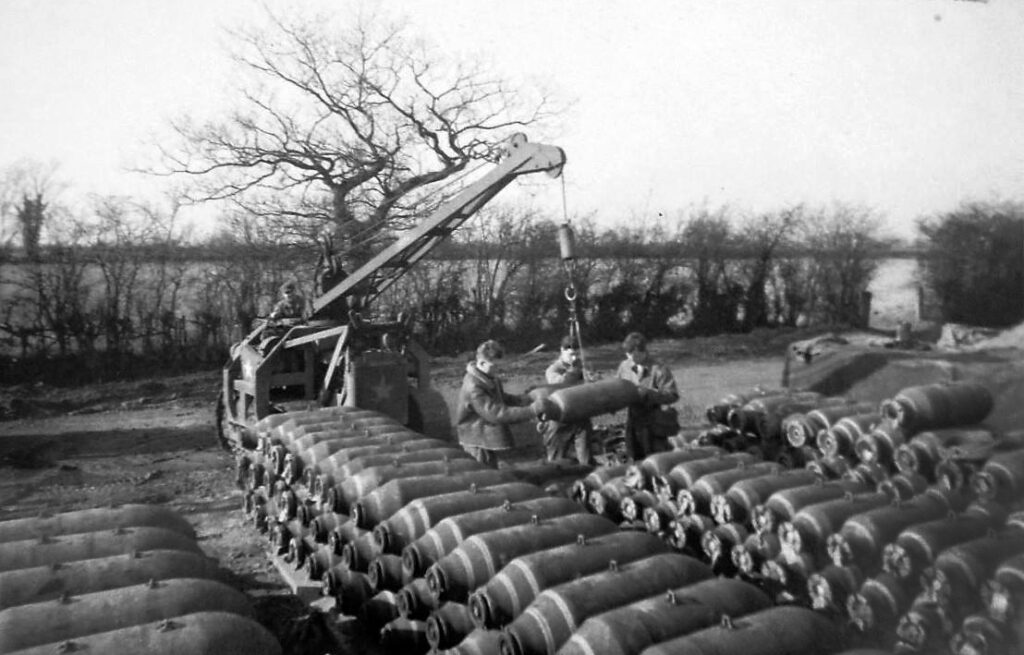
453BG armorers at the RAF Old Buckenham bomb dump. The bombs closest to the camera are AN-M64 500 pound GP bombs. To the far right are AN-M57 250 pound GP bombs.
500 lb GP bombs – both in the early M43 and later M64 variants – were the bombs most commonly used by the US Army Air Forces over Europe.
Photo taken 17 February 1945.
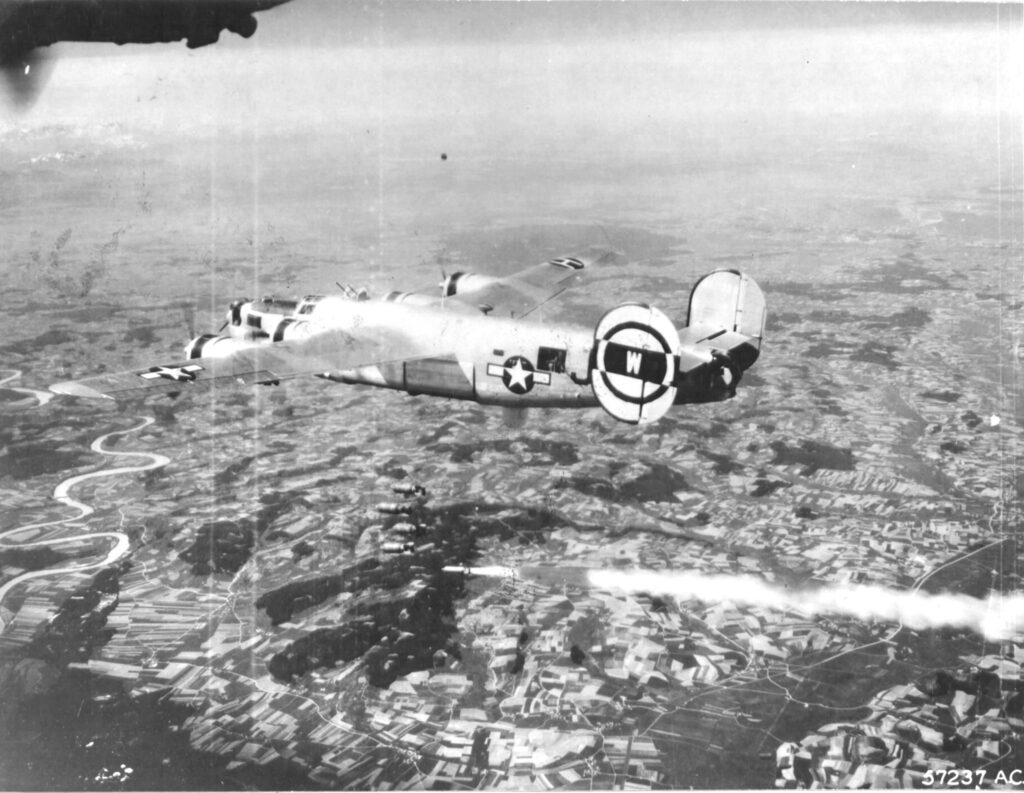
A Consolidated B-24M Pathfinder drops AN-M47s filled with chemical smoke agents alongside its standard payload on the railyards of Mühldorf, Germany. This area connected the factories of Munich and Töging am Inn with the concentration camp complex at Dachau.
Pathfinder bombers used Type H2X Radar Sets in place of their ball turret positions. In poor weather, the operator located the target by calculating its position off radar identifiable positions (such as mountains, rivers, and lakes). The target was then marked with smoke bombs so that following bombers would know where to aim.
Photo taken 20 April 1945.

Boeing B-29 Raidin Maiden (42-65276, 468BG) of the Twentieth Air Force is loaded with AN-M47 incendiaries.
The first incendiary-based area-bombing operation by the USAAF was carried out by XX Bomber Command (20AF) against occupied Hankow, China. While the operation was commanded by CG XX BC MG Curtis E. LeMay, the idea of using incendiaries was actually proposed by CG 14AF MG Claire L. Chennault, as a counter to Japan’s successful ICHI-GO offensive. The success of this test was later replicated over Japan and North Korea to devastating effect.
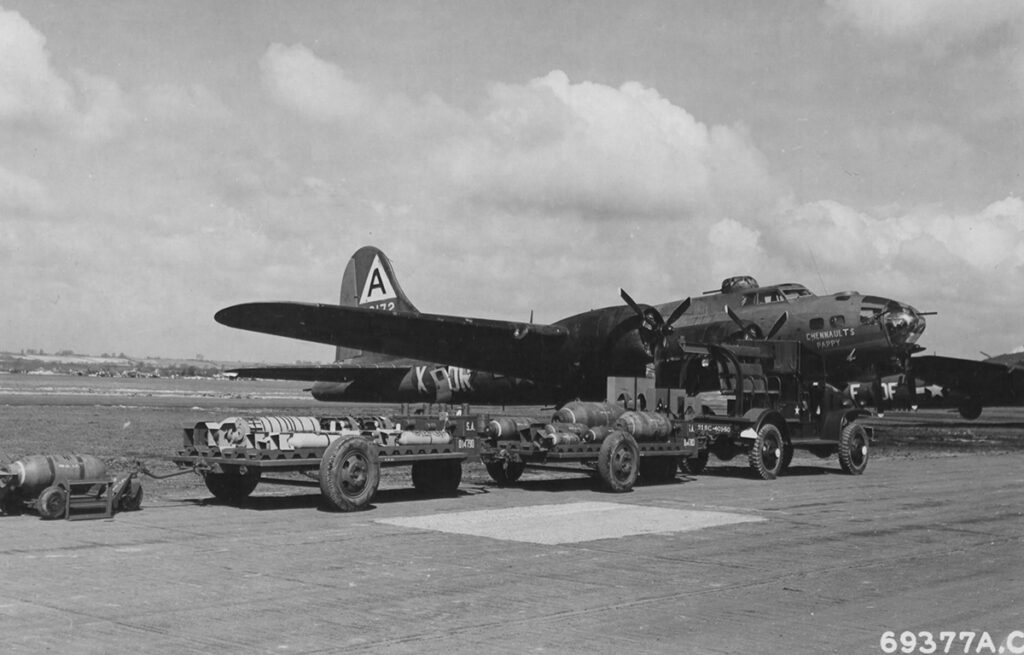
Chennault’s Pappy (41-3172, 91BG), being displayed with a variety of ordnance for photographers.
The name Chennault’s Pappy was a play on MG Claire L. Chennault, who was famous for his disdain of strategic bombing theory.
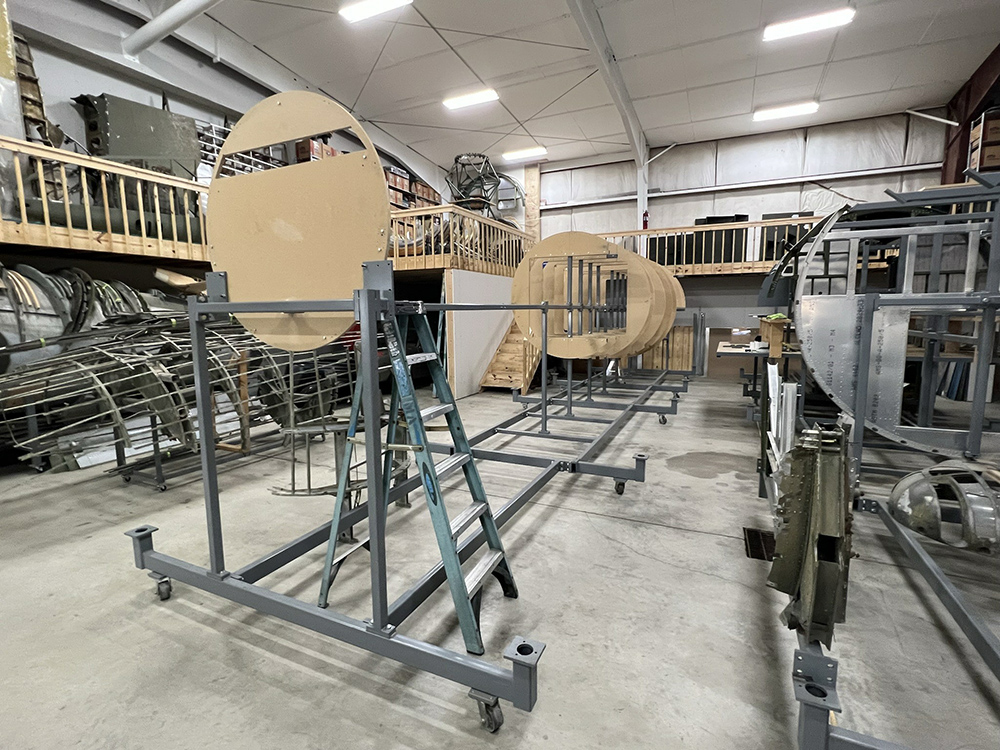
On an unrelated note…
The aft fuselage jig has been reassembled and work begun on yet another Boeing B-17.
Photo taken 23 April 2023.
I wanted to share today some pieces which we brought back from our trip to Connecticut.
First is a pair of pitot tubes we purchased from the New England Air Museum.
One of the things that distinguishes an F-model B-17 from a G-model is the bomber’s pitot tubes. While the Boeing B-17G had a relatively small pitot, the B-17F’s pitot tubes were quite prominent, sticking out from the nose like a large mustache. The type of pitot accurate to our aircraft was the Kollsman Type D-2. We have only come across one so far in our searching and it was wildly overpriced. So, we were pleased that the NEAM had a pair and were reasonably priced.
These pitots are still connected to their original masts, which we will be happy to trade or sell. One of the masts is off of a UC-78B Bamboo Bomber and the other from a Curtiss C-46 Commando. The pitot on the larger mast has a chrome finish, suggesting it is from a civilian aircraft, so if anyone has a wartime D-2, we would be happy to swap.
Next is a piece that we have been waiting for for a LONG time: a BG-109-A Accessory Bag for the B-17F’s SCR-578 Gibson Girl Emergency Transmitter.
Many of you are likely familiar with the Gibson Girl. The technical name for this unit was the BC-778. The BC-778 was a transmitter which the airman held between his legs and cranked like a butter churn. Doing so transmitted an automatic distress signal. This signal could be amplified by tying the antenna line to a kite or hydrogen balloon which accompanied the BC-778 as accessories.
The Gibson Girl (called this because of the transmitter’s hourglass shape) was introduced during the Second World War and stayed in service well into the 1970s. However, most surviving units are of a type introduced in 1944, which packed everything into a single, large square bag. Older variants, like the set carried aboard Lucky Thirteen, used a two-bag system, separating the transmitter from its various accessories.
This BG-109-A was offered to us by Cody Fisher of Camden, New Jersey in the summer of last year. Since we were passing by on the way to Connecticut, we were able to pick up this piece in person. The bag and its inner container are in excellent shape. The only pieces missing are the upper strap and the tin cap which covers the stiffener tube (we do not know of any surviving examples of the cap). We are working with Mitch Bertrang of the CAF’s Minnesota Wing to replicate the missing bits and maybe do something more…
Over the past couple years, we have managed to acquire two of the BG-110-A transmitter bags. In both cases, the previous owner had cut out the original parachute! Ugh!
Our friend Andy Rivera has offered to donate his postwar Gibson Girl kit to the project. This gave us the idea of building a display showcasing the various components that go into the SCR-578, while keeping the older bags on the airplane. If enough components come our way to outfit both the early and late kits, we will fill the older kit once the display kit is finished.

The newly acquired Type D-2 Pitot Tubes.
The masts holding them are from other aircraft and are excess to our needs.
Photo taken 30 March 2023.
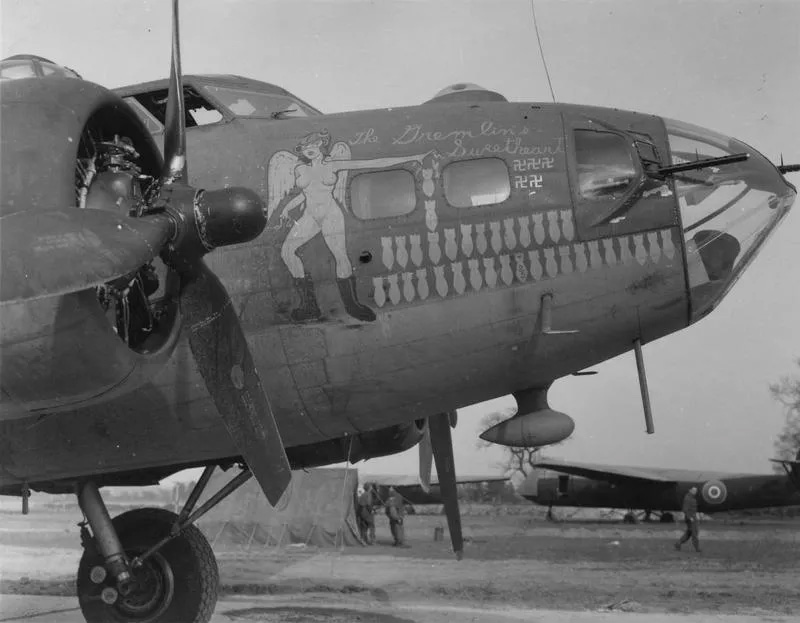
Gremlin’s Sweetheart (42-3400, 95BG), a Boeing B-17F almost identical to Lucky Thirteen as a late-F built by Douglas.
Note the pitot tubes on either side of the radio direction finder football antenna.
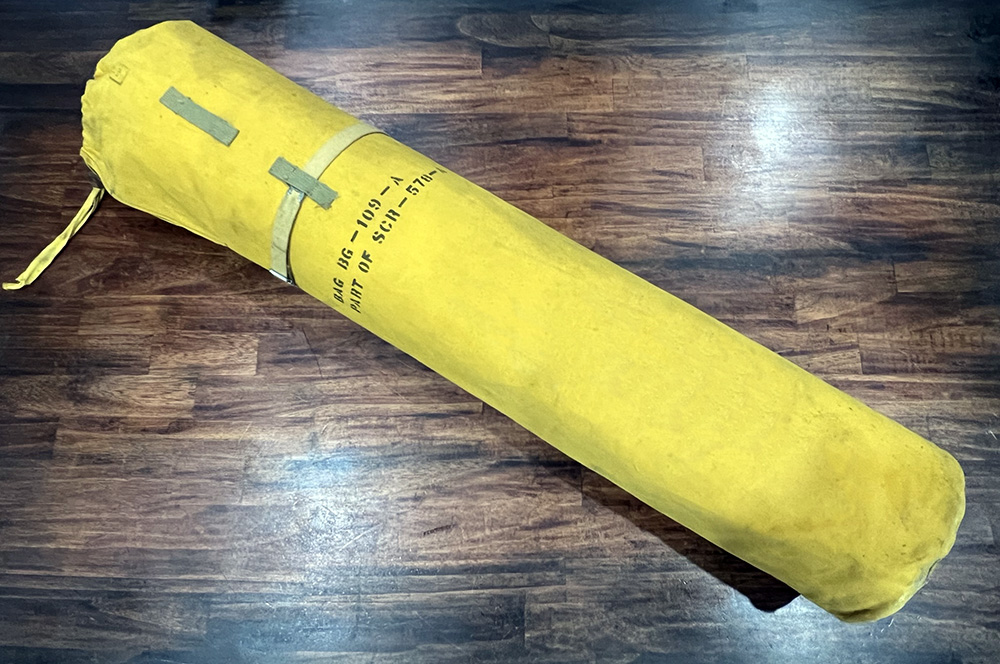
The newly arrived BG-109-A Accessory Bag.
The bag is quite large, measuring 7 inches in diameter and just under 4 feet tall.
Photo taken 31 March 2023.
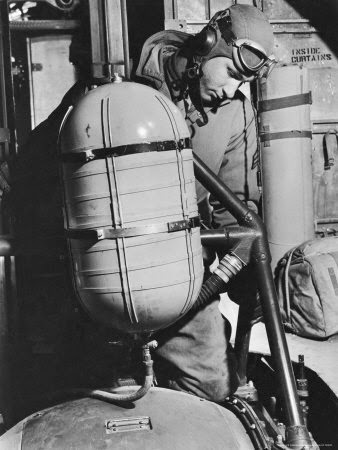
SSGT James M. Abbott, 97BG, adjusts the oxygen bottle that feeds his Type A-2 ball turret. The two early variant Gibson Girl bags are visible behind him.
We are only four Type G-1 Oxygen Tanks away from having a full complement of 18 for Lucky Thirteen.
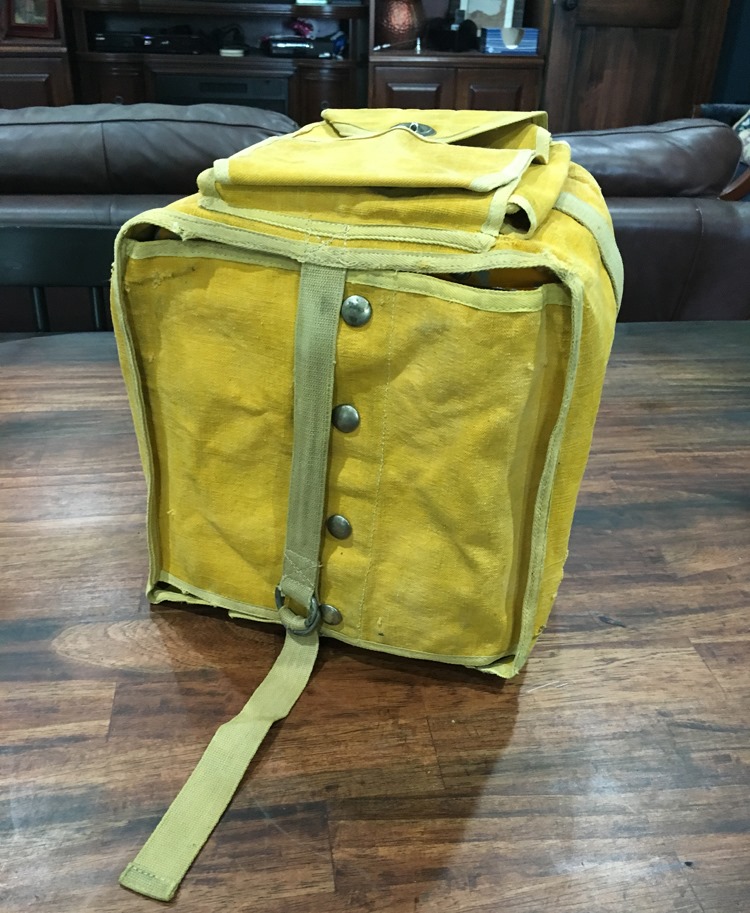
One of our two BG-110-A bags for the SCR-578 Gibson Girl emergency radio. The folds in the top are for its internal parachute, which was removed by a previous owner.
Photo taken 24 August 2019.
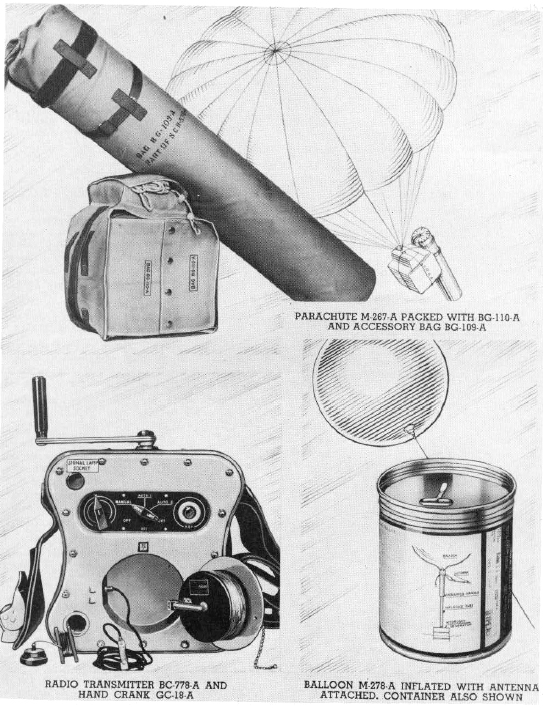

Manual photos illustrating the early variant SCR-578 and its various components.
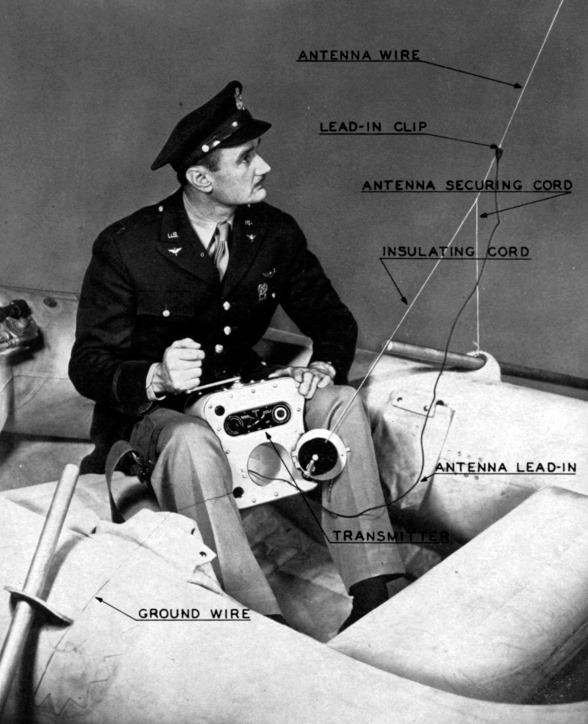
A manual excerpt shows the BC-778’s spooled wire being connected to the M-357 box kite.

A M-357 Kite which was donated to us last year, fully extended beside its packing tube.
Photo taken 28 June 2022.

Purchased alongside the BG-109-A was this M-278 Balloon. While the can was unsealed, the balloon (in the small bag) remains pliable.
This purchase would not have been possible without donations from our supporters!
Photo taken 30 March 2023.
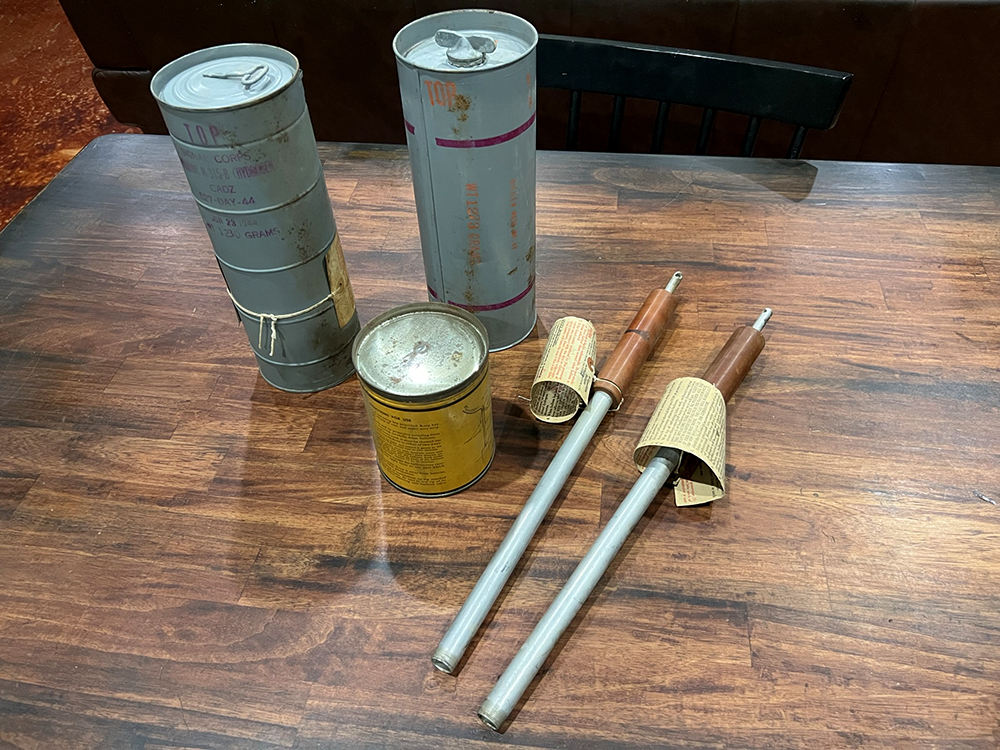
The M-278 Balloon can, along with a pair of M-315 Hydrogen Generator Canisters and their respective Inflating Tubes.
This purchase would not have been possible without donations from our supporters!
Photo taken 30 March 2023.
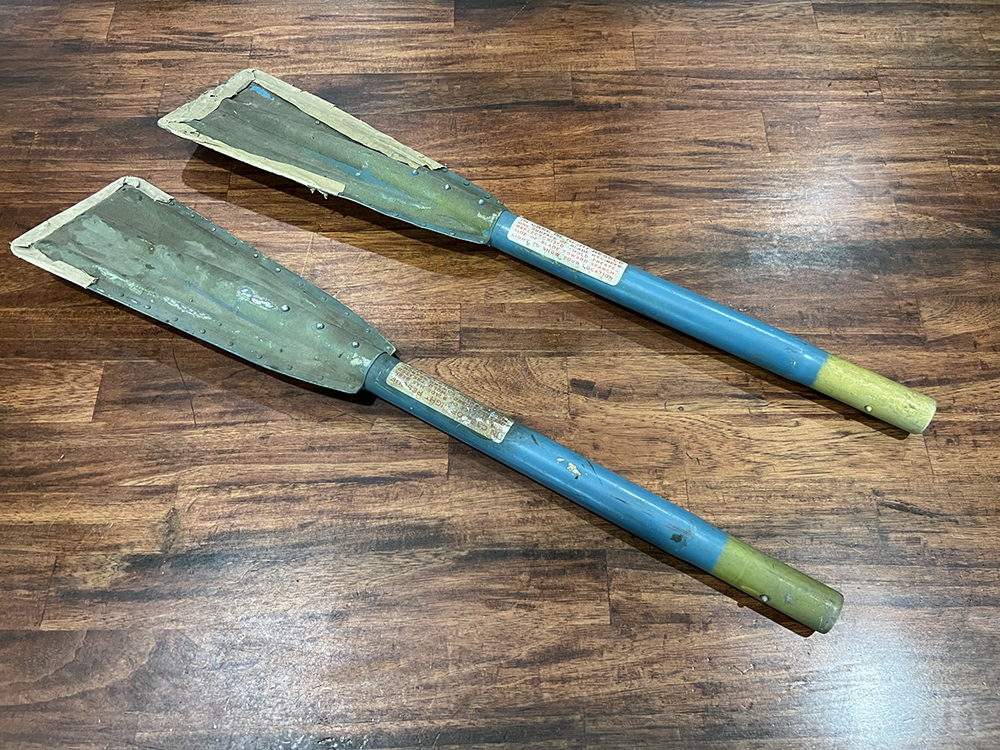
A pair of life raft paddles purchased for the project by Eric Miller of Project Warbird while in Connecticut.
Depending on variant, the Boeing B-17 carried a pair of either Type A-2 or Type A-3 life rafts on board. The paddles here came with the Type A-3.
Photo taken 31 March 2023.
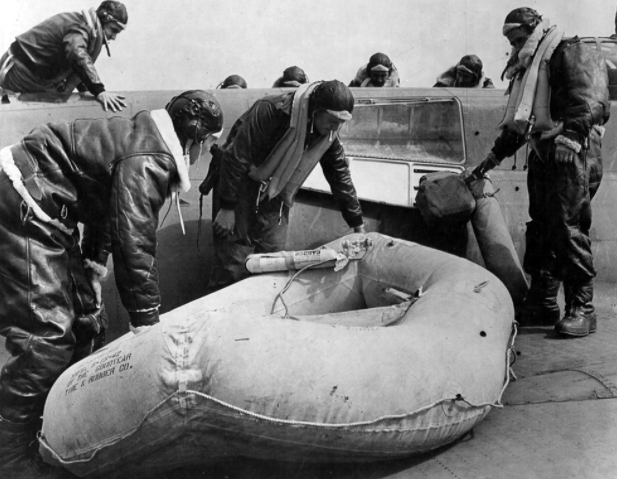
Airmen practice ditching procedures aboard a Boeing B-17.
The B-17’s life rafts were stowed above the bomb bay and were opened using a cable in the radio compartment.
Surviving A-2 and A-3 life rafts are quite rare and it is unlikely that we will be able to acquire a set for Lucky Thirteen.
